#it is stated in the movie that in Jerry's culture there are so many more genders
Explore tagged Tumblr posts
Text
I didn’t know there was an 80s movie featuring a canonically It/Its character. Just a reminded that even in media, even if slightly askew from now, we’ve existed in our own ways.
#nonbinary#enemy mine#80s movie#lgbtq+#it is stated in the movie that in Jerry's culture there are so many more genders#and that the humans foolishly only designated two#the people behind this movie had to be cultural anthropologists#just oh my god#this was so important and it was a movie my mom watched growing up#and as it was her first enby rep it makes sense that she always jumps to it now#i just#this was amazing#80s
6 notes
·
View notes
Text
Demon Lover Diary (1980)
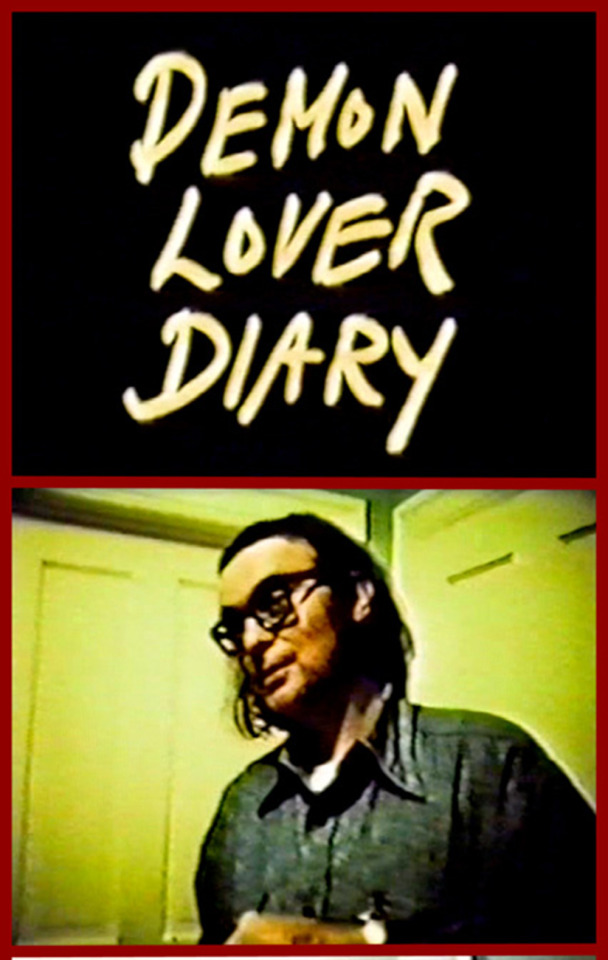
Movie #1,039 • WATCHLIST WEDNESDAYS
This is often cited as a proto-American Movie, and I get that, but it's funny how things get sorted in the cultural pecking order (like why isn't American Movie more recognized as an enhanced version of this, or is it dumb to equate the two just because they're both "making of" documentaries of low-budget midwestern horror flicks?); I've often stated that American Movie is my favorite/most likely the best doc ever made, so while I get the clear comparisons, there was a lot of ground for Demon Lover Diary to make up in my heart and mind.
Which is to say, I liked this but it's not on that level.
The actual finished product of the movie being chronicled here (albeit in almost unwatchable poor quality), The Demon Lover (1976) is floating around on YouTube as is a much better quality trailer...
youtube
... and the one takeaway from both of these is that it doesn't at all feel like the same movie Joel DeMott and Jeff Kreines were working on. Sure, it looks cheap and bad, but there's just a shit ton more happening visually that we never get to see in Demon Lover Diary. And to that end, yes, it did feel like directors Donald G. Jackson and Jerry Younkins (and much of the local cast/crew) were being made of fun (in a way, for example, Mark Borchardt clearly is not).
The novelty of seeing all the behind-the-scenes bullshit is really the only reason the doc is more notorious than the feature it's documenting. How many countless DIY productions — especially circa 1970s — could have been better served via this fly-on-the-wall testament? The reality is simply it was hard to come across one camera, let alone two.
I am much more intrigued by DeMott/Kreines' 1983 feature doc, Seventeen — for what it's worth. But remember...
SCORE: ⭐️⭐️⭐️⭐️⭐️⭐️
0 notes
Text
Anyway, Peter Parker is Bi, and I Won’t Be Convinced Otherwise.
Firstly, we have to get our bases covered. What exactly is Bi-sexuality? What is sexuality?
Sexuality is defined as a persons identity in relation to gender(s) they are attracted to. Why is this important? Peter’s sexuality has never been specifically stated in the comics, nor in any other form of media. It’s assumed that he is straight because of his popular relationship with Mary Jane Watson in the comics, and the movies.
Now that we have a bases for what exactly sexuality is and how it’s defined, let’s go over Peter’s partners.
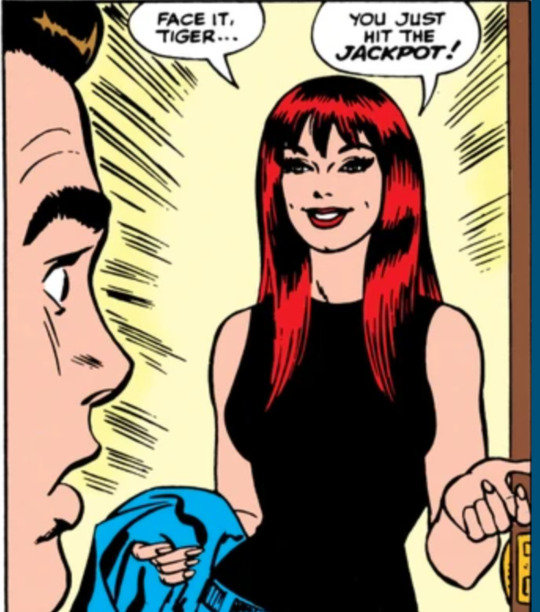
Obviously Peter and Mary Jane are a piece of comic book history. They eventually get married, though sadly, during the events of Civil War II (I think, don’t quote me) Peter and Mary Jane sell their marriage to Mephisto in order to save Aunt May

They later had their memories of their marriage restored, they have yet to get back together and it’s been a few issues if I remember correctly. Next we have Peter’s first, and most unfortunate love, Gwen Stacy.
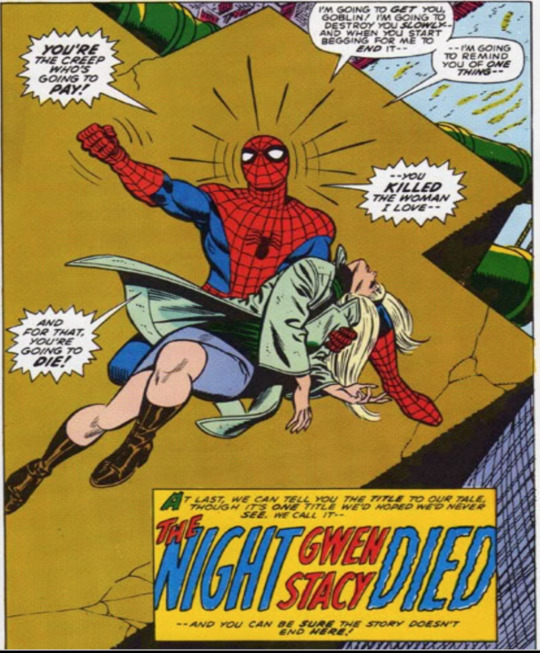
They dated in high school where she later died. Of course, Peter has dated other people (namely, Black Cat, Betty Brant, Carol Danvers, Anna Maria, Cindy Moon, Lian Tang, and so on). Since we have his known history of heterosexuality out there, we need to move onto another important part of Peter’s Bi-sexuality. An important implication in any media, especially queer media though, and that is the homoerotic subtext.
Homoerotic subtext is important part of queer culture, a lot of the time it’s used to portray a characters queerness without saying it out (see: Dorian Gray by Oscar Wild or Great Gatsby By Fitz). In current decade, homoerotic subtext is often used for queer baiting or creating more realistic male friendships.
So what’s the difference between someone creating a health male friendship (or a character comfortable in their heterosexuality) and implying a character is queer?
Here are some examples of a healthy male character, both with himself and his friendships.
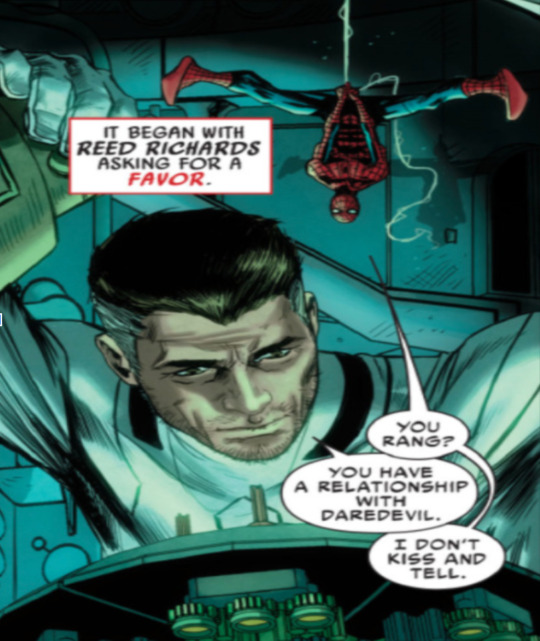
Clearly he’s just taking the shit, and messing around with Reed. He’s comfortable enough (or as I like to see it, so traumatized because good god this guy has been Spider-Man since he was 15 good god that’s awful. He probably doesn’t care anymore). Here are some examples of Peter a little more than just a straight man shooting the shit.
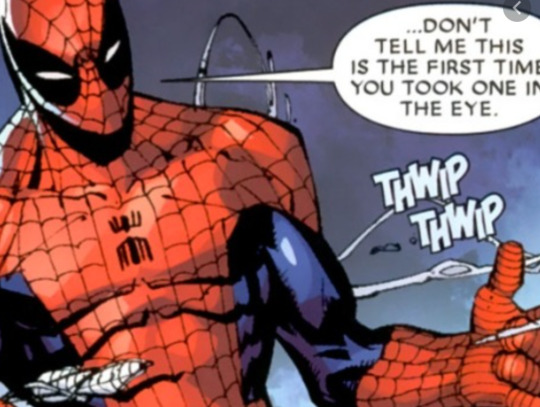
This has three meanings. Two of which I will take, one of which is just deeply embarrassing. Despite Peter’s history with humiliating events, I don’t think he would get his own spunk in his eyes. Leaving the other two options, he has experience getting spunk of - some kind - in his eyes, and/or he’s taking the shit again. Which is very likely.
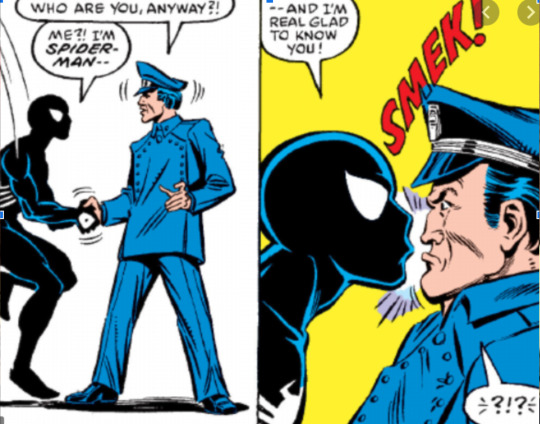
Kissing a cop? For....no reason? A little not so hetero of you Peter.
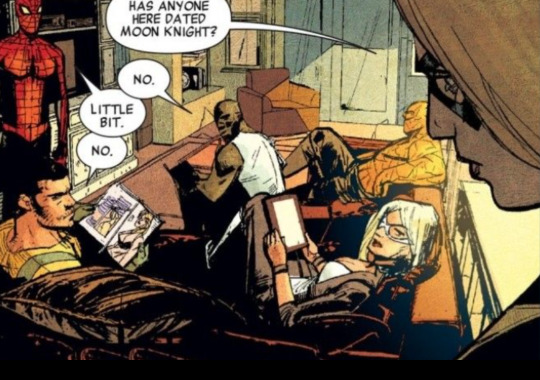
You can practically hear his disappointment in his voice. Also could be read as taking the shit, but why would you.
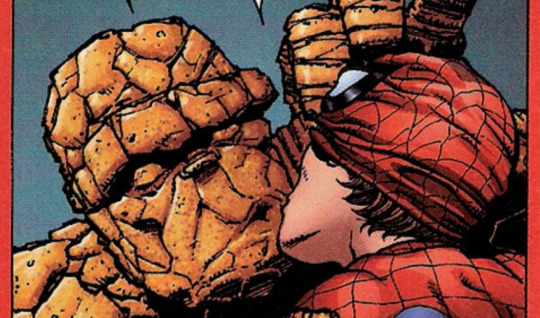
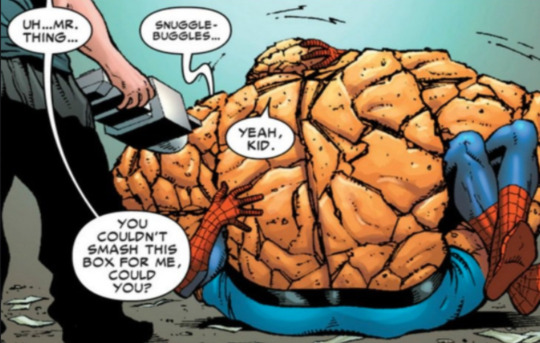
Making out with The Thing? Gay.
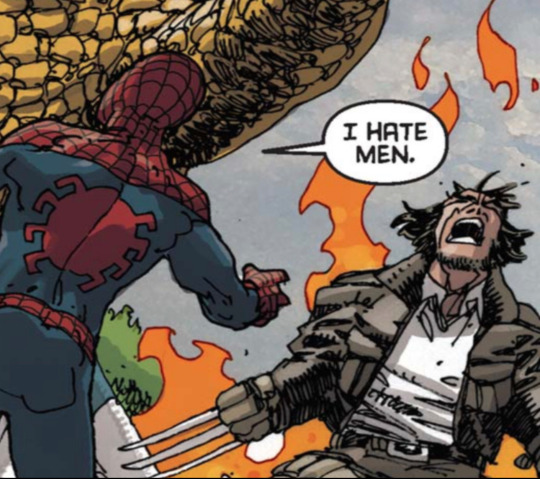
This one is the most important. Peter is clearly tired, annoyed by his teammates (see wolverine being wolverine in the corner). Shits on fire, its mid battle, and Peter has the audacity to mutter “I hate men” to himself. The only people I have every heard say this in that was are lgbt and straight women, and lgbt men. This kind of expression only comes from people who date, or deal with men in a completely different world than straight men. Straight men use this phrase as an endearment, “Oh have you seen Bill today, I hate that guy.” “Man Jerry can do so many push-ups, I hate that guy.” Very different language, and implications (I also, obviously don’t know how straight men speak).
Now that we’ve gone over our bases, and homoerotic subtext. How else could we gather that Peter Parker is Bi? There are many tropes in media - queer media - that allure to a characters queerness. Like homoerotic subtext, there are ways to tell an audience something without specifically saying it.
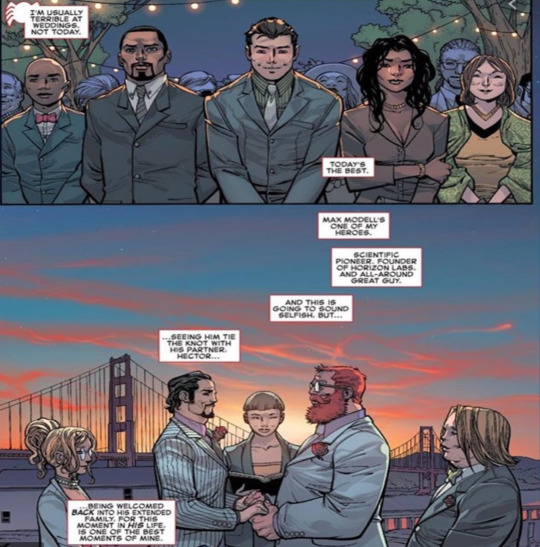
This is a gay wedding Peter went to in the recent comics. I don’t know if any of you have been to a gay wedding recently, but Peters face (the first panel above the wedding) is the same exact face I made at my first gay wedding. It’s the face of excitement for not only the couple, but for yourself. The hope that maybe, you too can actually be in a same-sex relationship.
I’m also going to allure to queer tropes as stated previously. Such as the real, and fictional trope of lgbt people sticking together. Thousands of years of belittlement and oppression will make groups of people not want to wonder out, and subconsciously look for others like them.

Johnny Storm (and Wade Wilson since he comes in later but I couldn’t find a picture of the confirmation) is cannon Bi-sexual (Pan-sexual).
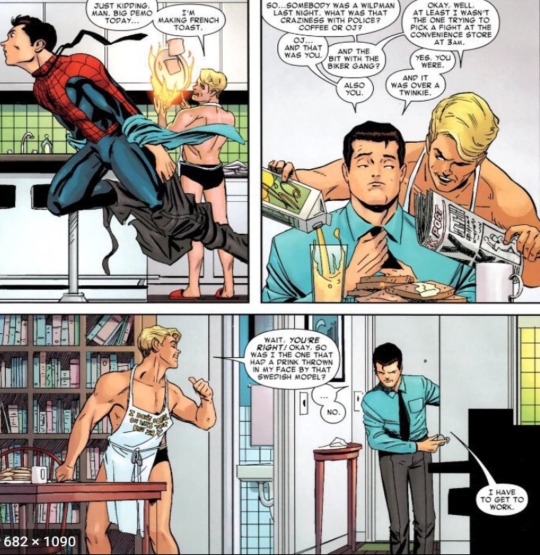
Their friendship is deeply homoerotic as most queer friendships in media and real life are. Johnny flirts with Peter on many occasions (saying his ideal women is a female version of Peter, inviting him over to watch is sex tape, and so on) and of course oh my god they were roommates.
Some other popular queer tropes are: Found Family, Soulmates, and Enemies to lovers. Because it’s superhero related, this includes the Identity Porn tag as well.
Peter Parker and Wade Wilson have a famous Love/Hate relationship. I mean, how could you expect anything less when your first meeting with this known mercenary is him throwing your civilian persona out the window of a car. Now, Wade still doesn’t know Peter is Spider-Man in the current run of comics, but that doesn’t make anything about them any less gay.
For the Found Family Trope:
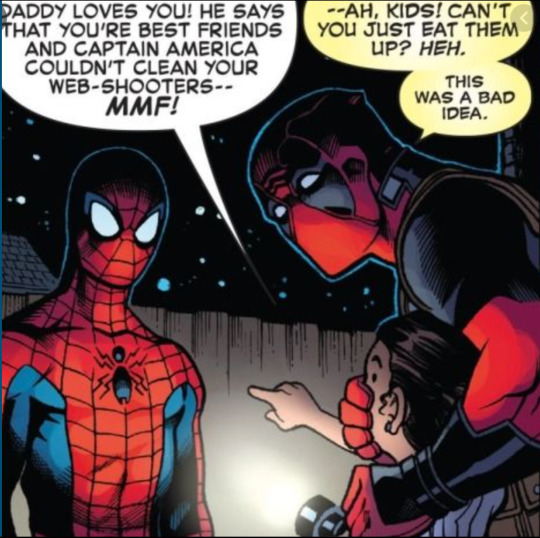
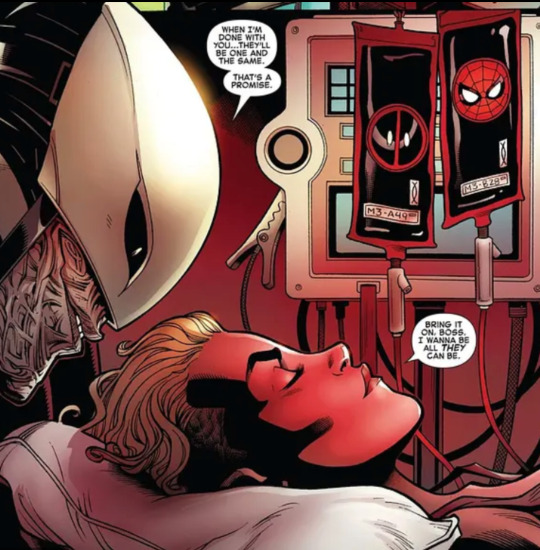
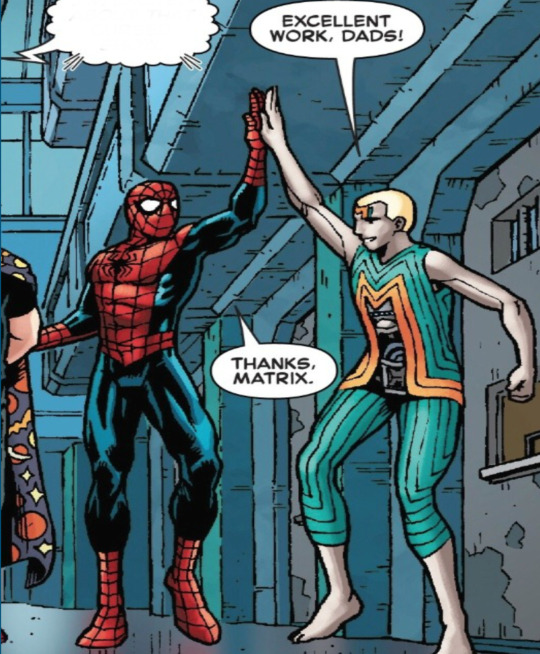
Because it’s Peter and Wade, their whole development can be read as Enemies to Friends to Lovers, so I wont bother backing that up because, uh, it speaks for itself. One panel really does to add that cause though
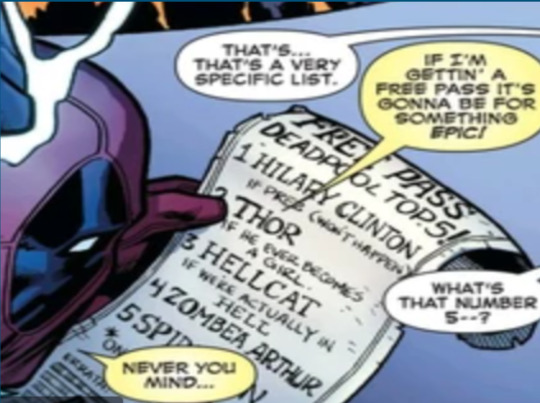
I’m not going to explain what a free-pass list is.
The Soulmates part I know I have to back up.
For SoulMates:

Now this panel requires a little explanation. Wade kills Peter, not knowing he’s Spider-Man. Weasel takes over for Peter (they don’t know its him) so no one suspects he’s dead. Deadpool begins to feel guilty he killed his best buds best bud, so he tries to bring Peter back to life. Losing his stunning good looks (switching back to how he looked before Weapon X making his wife Shiklah estranged (then she married Dracula but thats beside the point)). Spider-Man is Peter’s “true self” or patronus for Harry Potter fans. Wade is stupid and hasn’t connected the dots yet, effectively making him the biggest simp in history. Seriously, who destroys their marriage for the c h a n c e for getting some with their idol? A Simp, that’s who.
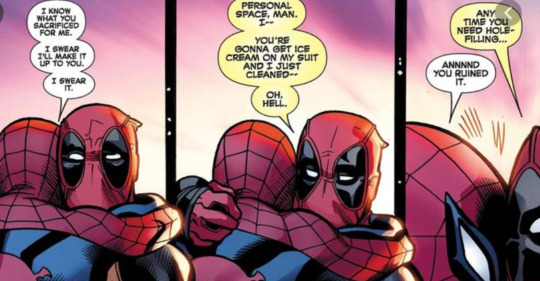
Peter forgives Wade for killing him (and for saving him from killing their genetic daughter itsy-bitsy). If someone killed me they better be hot as fuck before I even thing about forgiving them. Ignoring Peter’s super sexy forgiving nature, uh, he’s kinda simping.
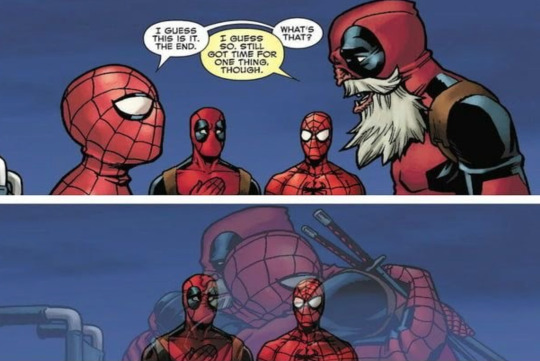
Died in each others arms. Nothing else is needed.
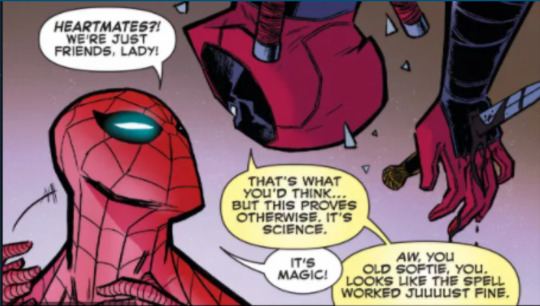
They’re heartmates. From what I read, the feeling has to be mutual in order for it to work. The witches (long story, comics are hard to explain) that captured deadpool were expecting his wife so they could get the headmistress back. Instead, they got Peter. Basically Heartmates = soulmates but chosen for you instead of chosen by you.
To conclude my point:

Thank you for coming to my TED Talk.
#Peter Parker#Bi#Spider-Man#Deadpool#Johnny Strom#Mary Jane#He's bi and I wont be told other wise#thanks for coming to my ted talk#Bi-derman#bi wife energy#spideypool#spideytorch#he's gay but go off I guess marvel#aunt may#marvel#Fantastic Four#Reed Richards#The Thing#LGBT#Gwen Stacy#Anyways: the series
961 notes
·
View notes
Photo
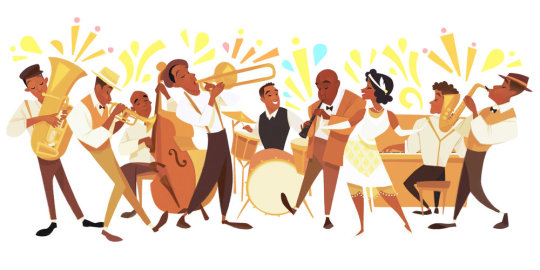
Possessed: Voodoo’s Origins and Influence from the Blues to Britney
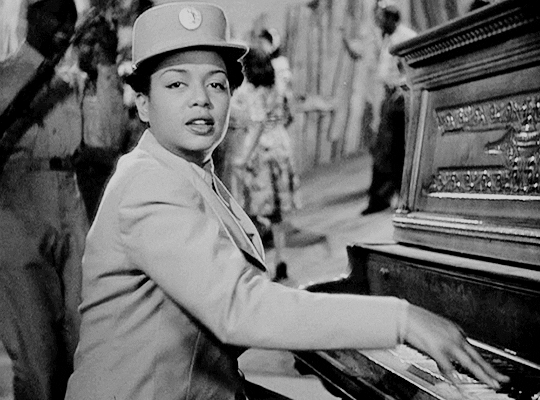
Blissed-out, ecstatic union with our divine selves — we seek it at raves and rock concerts, and in the desert with the Burning Man. I try to get there when I’m jamming with my band — but I didn’t realize until I wrote The Language of the Blues: From Alcorub to Zuzu how much this longing relates to West African spirituality, and the Voodoo concept of possession.
Vodou (the proper Kreyol/Creole spelling of Voodoo) is a neo-African religion that evolved in the New World from the 6000-year-old West African religion Vodun. This was the religion of many slaves brought from West Africa to the Americas and the Caribbean.
Vodun was brutally repressed by slave-owners, yet its powerful beats, ethics and aesthetics endured. We owe our concepts of cool, soul and rock and roll to it.
The roots of rock are in a West African word for dance — rak. As Michael Ventura wrote in his important essay on rock music, “Hear that Long Snake Moan”:
The Voodoo rite of possession by the god became the standard of American performance in rock’n’roll. Elvis Presley, Little Richard, Jerry Lee Lewis, James Brown, Janis Joplin, Tina Turner, Jim Morrison, Johnny Rotten, Prince — they let themselves be possessed not by any god they could name but by the spirit they felt in the music. Their behavior in this possession was something Western society had never before tolerated.
Vodou possession is not the hokey demon-possession of zombie movies; it’s a state of union with the divine achieved through drumming, dancing and singing. It’s becoming “filled with the Holy Ghost” in the Pentecostal Christian tradition or attaining yogic bliss through the practice of kirtan, singing the names of God — Hare Krishna, Hare Krishna.
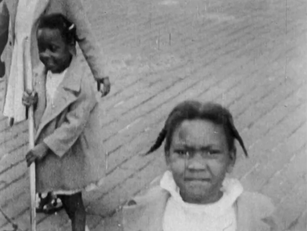
In the Yoruba culture of West Africa, being able to connect with one’s inner divinity is called coolness (itutu). In Yoruba morality, generosity indicates coolness and is the highest quality a person can exhibit. In American culture, we say that nice person is cool, or that a musician “has got soul.” We notice “Southern hospitality.”
The Trans-Atlantic slave trade carried these ideas to the New World, particularly as slavers burrowed inward from Senegambia on the West African coast to the Kingdom of Dahomey, a Vodun stronghold.
Dahomey spread across much of today’s Togo, Benin and Nigeria and was heavily involved in the slave trade. Vodun practitioners were shipped overseas by the thousands when the Fon people of Benin conquered their neighbors, the Ewe, in 1729. Many Fon were also kidnapped and traded into slavery in exchange for textiles, weapons, brass pots, Venetian beads and other European goods.
Vodun is a Fon-Ewe word meaning God or Great Spirit. This supreme creator was represented as the giant snake Dan carrying the universe in its coils. Today, in Haiti and American Vodou strongholds like New Orleans, Dan is worshiped as Damballah, the Grand Zombie (the Bantu word nzambi means God). He’s John Lee Hooker’s “Crawling Kingsnake”.
Branching off from this almighty God-force are spirit-gods called loa. During Vodou ceremonies, a loa may descend the center post of the temple to possess or “ride” a worshiper who has reached a sufficiently high state of consciousness. The morality implicit in this is stated in the Haitian proverb, “Great gods cannot ride little horses.”
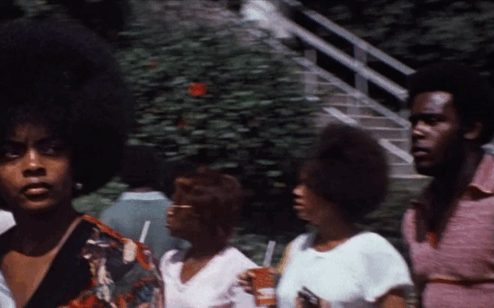
Vodun practices like drumming were definitely noticed by nervous colonists who had imported fierce warriors and tribal priests to work their farms. After a deadly rebellion in the South Carolina colony in 1739, the colonists realized slaves were using talking drums to organize resistance. The Slave Act of 1740 in South Carolina barred slaves from using “drums, horns, or other loud instruments.” Other colonies followed suit with legislation like the severe Black Codes of Georgia.
Soon, religious repression was in full swing. Slaves caught praying were brutally penalized, as this excerpt from Peter Randolph’s “Slave Cabin to the Pulpit” recounts:
In some places, if the slaves are caught praying to God, they are whipped more than if they had committed a great crime. Sometimes, when a slave, on being whipped, calls upon God, he is forbidden to do so, under threat of having his throat cut, or brains blown out.

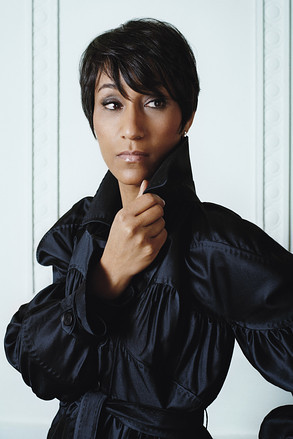
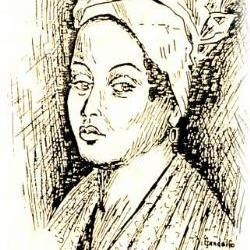
Vodun practitioners taken as slaves to plantations in Haiti, Cuba, Brazil, and Jamaica were also prohibited from practicing their religion. But enslaved Vodun priests arriving in the Catholic West Indies quickly grasped similarities between their tradition of appealing to loa to intercede with God, and Catholics praying to saints for intercession. By superimposing Catholic saints over the loa, slaves created the hybrid religions Santeria (saint worship) in the Spanish Islands, Vodou in Haiti and Candomblé in Brazil.
On Aug. 22, 1791, Haitian slaves revolted on a signal from Vodou priests, who consulted their oracle to determine which military strategies would succeed. The revolutionaries defeated Napoleon Bonaparte’s army and declared independence Jan. 1, 1804, establishing Haiti as the world’s first black republic. Freaked by a successful slave revolt, the United States and Western Europe slapped economic sanctions on Haiti, turning the prosperous colony into an impoverished state that could no longer sell the products of its fields.
In 1809, Vodou arrived in the United States en masse when Haitian slave owners who had fled to Cuba with their slaves were expelled. Most relocated from Cuba to New Orleans, nearly doubling the city’s size in one year. Today, 15 percent of New Orleans practices Vodou, and it’s popular in other U.S. cities with African and Haitian communities.
Among the arriving Haitians was Marie Laveau. She became the leader of New Orleans Vodou practitioners in 1820 when she was elected the human representative of the Grand Zombie. (Former White House Social Secretary Desirée Rogers is descended from Marie Laveau.)

Laveau kept a python named Zombi, and danced with it on her shoulders while presiding over ceremonies. This image was appropriated, with other Vodou nods, for Britney Spears’s “I’m a Slave 4 U” performance at the 2001 MTV Video Music Awards.
The sensationalistic 1884 book Haiti or the Black Republic by Sir Spencer St. John, slammed Vodou as an evil cult, with gruesome descriptions of human sacrifice and black magic — some of which had been extracted from Vodou priests via torture. It became a popular source for the Hollywood screenwriters who began churning out voodoo horror flicks in the 1930s.
The first musician to bring pop-Voodoo imagery to the stage was Screamin’ Jay Hawkins, who would rise from a coffin onstage with a bone in his nose. Hawkins had intended for his hit record “I Put A Spell On You” to be a soulful ballad. But once the producer “brought in ribs and chicken and got everybody drunk, we came out with this weird version,” Hawkins admitted, adding “I found out I could do more destroying a song and screaming it to death.” Hawkins kicked off the undead craze among rockers like Alice Cooper and Marilyn Manson.
Meanwhile, despite the severe repression, Vodun practices crept into Southern black churches. Descriptions of black Baptist church services in the late 1800s and early 1900s depict the congregation dancing in a circle in a “rock” or “ring shout” as they follow the deacon, who bears a standard.
It was the deacon’s job to whip parishioners into a frenzy of fainting and speaking in tongues called “rocking the church.” The concept of a deity “riding” with a worshiper transferred to these Christian churches, where the cry “Drop down chariot and let me ride!” was often heard, as well as “Ride on!” and “Ride on, King Jesus!” This became the solidarity shout, “Right on!”
Blues singers fronting big bands, like Joe Turner and Jimmy Rushing, copied the way church solo singers belted over the choir. The radio beamed this new “shouting blues” all over black America. It was picked up by country blues singers like Muddy Waters and T-Bone Walker, who had moved to Chicago and used it with their new electrified bands. These, in turn, inspired rockers like Janis Joplin, Jimi Hendrix, The Beatles and The Rolling Stones
Africans brought here as slaves carried with them incredibly strong aesthetic, ethical and cultural values that not only withstood the shock of their forced transplantation to the New World, but transformed and invigorated it. Their influence made us uniquely American. It’s why we respond to that Voodoo beat.
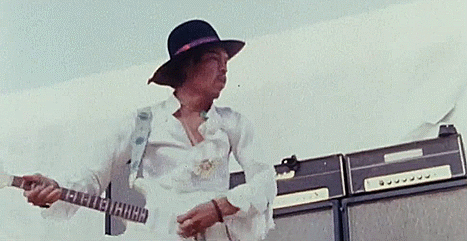
#africans#african culture#vodun#vodu#kemetic dreams#jimi hendrix#blues#jazz music#jazz#yoruba#igbo#africanspirituality#africanamericans
884 notes
·
View notes
Text
4 seats away

College!AU Iwaizumi x gn reader (part1/?)
Iwaizumi Hajime was an absolute mystery to you when you first met him. Despite being just 4 seats away, the distance between you seemed like oceans apart. Little did you know of just how the tides would turn to bring the two of you a little closer.
slowburn-friends to lovers-flufff
(warnings- cuss words, mentions of harassment)
a/n; this is my first ever fic so feedback would be appreciated!
Stepping onto your college campus for the first time, you felt both exhilarated and scared, but nonetheless, you were ready to take on your new life and all the adventures that it had in store for you.
On the other hand, Iwaizumi Hajime was absolutely baffled by just how much california was different from the place that he had called his home. He had expected some adjustment difficulties but still, he wouldn't have guessed the cultural shock that hit him harder than that one ball he spiked at shittykawa’s head when they were second years. His lips twitched upwards at the thought of his best friend who he was miles away from. But then his eyes moved to the mess of cardboard boxes he still had to unpack, and just like that his face was set back into it’s usual stoic expression as his shoulders slumped and he got to work.
--------
2 months into college life and it had surpassed all your expectations of the freedom you had deemed to gain as a high school student. No, you weren't going to parties every single night, spending your day away drinking booze or getting high at 2 am while listening to arctic monkeys. But you could get waffles at 2:30 am if you wished to, eat nutella straight out the jar AND play the yarichin bitch club’s theme song on the living room television and dance around with your roommates with no judgment whatsoever.
Who was there to judge you after all anyways?
Unfortunately, that carefree attitude crumbled to dust as you walked out your class, absentmindedly texting your friend, and immediately slammed into what seemed like a walking brick wall. It took you 3.5 seconds to hear the clutter of the books and stationery the stranger was carrying to fall onto the floor, and another second to snap back to reality. You hurriedly bent down and hastily gathered the mess while a string of almost incoherent apologies left your mouth. Realising the lack of response from the mystery person, you snapped your head up wondering if you may have given them a concussion with just how hard you knocked into each other. Instead, you were met with honey brown orbs peering down at you from a face as cold as ice. You didn't even realise how hard you were staring until the unknown boy bent down, taking the items from your hands gently and gathering the rest from the floor. His husky but tender voice snapped you of your trance. He seemed to murmur an apology before slightly bowing and then stopping halfway as if he caught himself doing something wrong. Another “sorry” and a slight nod was all you got before he walked away.
That was your first encounter with what seemed to be an ever perplexing and mysterious boy. Fortunately, it wasn't the last.
---------
The next time you saw him was on the bus on your way to the cafe where you worked part-time. You didn’t realise his presence until you felt a pair of eyes boring into the back of your head with an intensity hard enough to cut through stone. As you turned your head around, your eyes locked onto each other. He was standing around 4 seats away from you, partially blocked by a middle aged man talking loudly on his phone. Instinctively, you waved at him with an awkward smile. To your surprise, he raised his hand back in greeting while giving you a slight nod. Just then, your pressed smile turned into a genuine one as the distance of those 4 seats seemed to lessen just a bit.
-------
Since then, you had learned a little bit more about him. He had a class right next to yours. He didn't seem to interact much with too many people, but was always polite to everyone and had one constant friend who he was most often seen with. He was somehow also extremely oblivious to his popularity amongst the girls he had classes with (they had given him the title of the “mysterious hot foreign boy”). You truly questioned that when you once saw him try to baby talk to a cat while waiting for the bus, only for the cat to poke him right in the eye with its paw, leading to a very awkward 5 minutes of you asking him if he was okay and him reassuring you he was even though his eye twitched every two seconds.
------
It was just another regular day for you travelling back from work. You had gotten onto the bus, followed your daily routine of acknowledgement given and received with “that one guy from college”, and went along your business bobbing your head along to the song you were listening to on your earphones. The bus was oddly crowded that day for a late afternoon in the middle of the week. Your senses seemed to heighten a little as you felt a tall figure enter your personal bubble. You tried to move around, but the task proved to be a little too difficult with the crowd and a seat right next to you blocking your way. A single road bump was all that was needed for the stranger to further invade your space as they pressed up against you, a hand slowly inching up your hip. Your breath hitched in your throat as you looked around with a panic filled expression, your eyes locking onto a pair of almond orbs you had grown too familiar with.
It didn't even take Hajime a second to read your terror filled eyes and look down to realise the situation. And before he knew it, he was pushing through the crowd and physically placing himself right between you and the man.
“Is there a problem?” he asked in an ever threatening tone to the man who was currently chuckling nervously as he cowarded away from Hajime's terrifying build. The man stuttered out an incoherent string of words that you were too shaken up to register before Hajime took one frightening step towards him, sending him scrambling away as far as possible in the stuffed bus.
Hajime turned towards you, intending to move a step away from you to give you the much needed space. But before he could do that, he felt something tug onto the fabric of his jacket. Looking down, he saw your fist bundling up the corner of his jacket and he could have sworn he felt the sound of his heart break a little as he looked up to see a tear fall from your eyes as you sniffed slightly.
“Hey, it's alright. Your name’s y/n right? You’re safe now y/n.”
You were still too shaken up to wonder how he came to know your name or to even answer when he asked you if he should walk you back to your college dorm building. He took your fragile state as a yes as he simply signalled you to walk before him with a light tap to your arm when your stop came. You both walked in silence with you leading the way. When you reached right outside your dorm buidling, you finally looked up at him to thank him, only to see the smallest of smiles grace his lips as his eyes slightly darted down in between you two to where you still held onto his jacket. Your eyes widened as you realised you had never let go of it. That caused a small chuckle out of the usually stoic faced brunette. You found yourself letting out a nervous laugh as you pulled your hand away.
“Oh god, I’m so sorry, I didn’t even realise it. And also sorry for the extra journey you had to make. I honestly don't know how to thank you for what you just di-”
“It’s really not a problem. Besides, anyone would have done that. I just hope you are okay?”
---------
The ice between you and Hajime hadn't been a slow process of thawing and melting. Instead, it had come crashing down and swept away as if in a thunderstorm. From that day onwards, Hajime himself had taken the initiative to cross the everlasting distance of those 4 seats between you. Small talks while standing next to each other soon enough turned into dying of laughter as Hajime made stupid faces at the baby in the arms of the woman in front, or the time you sneaked in a wholeass tub of ben and jerry’s and shared it with him right in front of the “no-food” sign on the bus.
You learned something new about him almost everyday. He was majoring in sports science. He used to play volleyball in high school. He has a best friend who currently plays volleyball in a professional team in argentina. The said best friend also blames himself for why they did not go to nationals as third years even though that is absolutely not the case. Not that Hajime would ever tell him that. Hajime sometimes has extremely soft moments when you’re texting late at night, thus leading to appreciative conversations about his best friend. Not that he would ever address him as that on a regular day, instead opting for shittykawa or trashykawa and many other terms, that, as pointed by you, seemed to be getting lazier by the day on a creative level. At this point, you’re sure you know his best friend more than he knows himself.
Anyways, back to Hajime; he’s weirdly good at carnival games (much proven by his 5 time winning streak over you in the bucket toss). He always ends up choosing the dinosaur plushie as his prize (you now have an ever increasing collection of dinosaur plushies by your bed).
He loves staying healthy and learned how to make all his favourite foods from back home in the first two months of coming to Cali. His favourite being agedashi tofu, which he now has to make for you at least once a week since you have been obsessed with it ever since you first tried it from his plate (he acts like he’s pissed about it but low key loves seeing how your face lights up whenever you see him with a lunchbox in front your class). He’s very attentive to whatever you say or do and will happily watch your favourite anime/movie/show as long as you're willing to watch all the godzilla movies with him.
There is still so much to learn for you to learn about Hajime, and you are more than willing and ready to do so. However, there are a few things that you don’t know of and Hajime would like to keep it that way. Like how he looks over at you with such tenderness in his eyes while you’re laughing at a video of puppies falling over, or how his heart swells with joy whenever you get on your tiptoes to fix his hair, or how sometimes he’ll catch your face just right in the sunlight and suddenly he’ll feel like everything would fall apart if he so much as breathes too loud. But you’d always snap him out of it by poking your tongue out at him while making the silliest of faces and he’d flick your nose in response, and once again he’d ground himself into the moment, simply enjoying the fact that you exist, you’re here, and you’re with him. He mentally thanks himself for crossing those 4 seats that led him to being this close to you almost every other day. But he wonders if he’ll ever be able to get past his cowardice and admit that maybe he wants you to be just a little bit more closer.
#hq#haikyuu#iwaizumi fluff#iwaizumi imagine#iwazumi x you#haikyuu x reader#hq x read#hq x you#oikawa fic#iwaizumi hajime#haikyuu headcanons#hq smut#hq college au#haikyuu imagines#iwaizumi angst#haikyuu angst#haikyuu slow burn#friends to lovers#iwaizumi scenarios#iwaizumi oneshot#iwaizumi comfort#haikyuu gn!reader#haikyuu au#asks open#send asks
116 notes
·
View notes
Text
round up // MARCH + APRIL 21
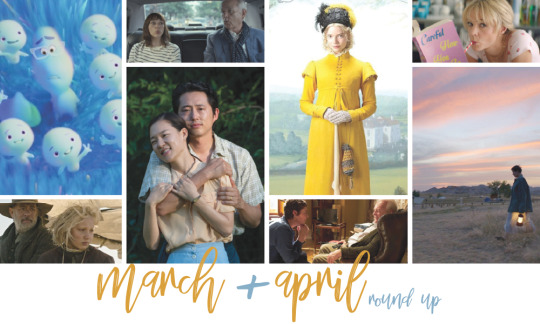
March and April were a whirlwind of vaccines and awards shows! A full year after we starting staying at home, the end of this weird chapter in recent history seems like it might finally be coming to a close, and this pop culture awards season—typically a time full of fun and glamour—captured our moment weirdly well. (Emphasis on the weird.) This month’s recommendations is filled with more Critic Picks than usual, so without further delay, let’s dive right in...
March + April Crowd-Pleasers
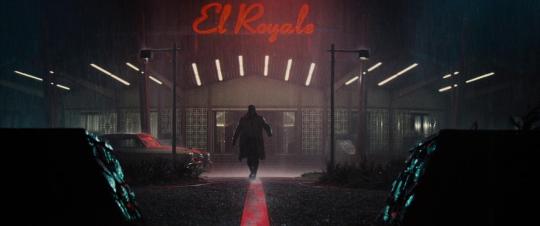
Double Feature — 2018 Action Thrillers: Bad Times at the El Royale + Den of Thieves
In Bad Times at the El Royale (Crowd: 9/10, // Critic: 8/10), Jeff Bridges, Cynthia Erivo, Jon Hamm, Chris Hemsworth, and Dakota Johnson are staying at a motel on the California-Nevada state line full of money, murder, and mystery. In Den of Thieves (Crowd: 9/10 // Critic: 6.5/10), Gerard Butler takes on some of the best bank robbers in the world. Whether you like your action with a dose of mystery or the thrills of plot twists, these will fit the bill.
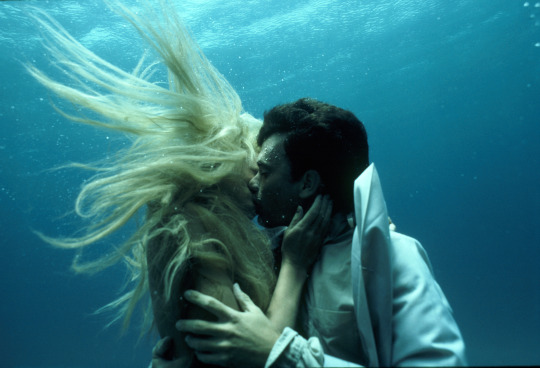
Double Feature — ‘80s Comedies: Caddyshack (1980) + Splash (1984)
In the mood for pure silliness? Take your pick between a mermaid and a gopher! Five years before The Little Mermaid, Tom Hanks fell for Daryl Hannah’s blonde hair and scaly tail, and John Candy was his goofy brother in Splash (Crowd: 8.5/10 // Critic: 7/10). And four years before Ghostbusters, Bill Murray was the goof on a golf course full of funny people like Chevy Chase, Rodney Dangerfield, and Ted Knight in Caddyshack (Crowd: 8.5/10 // Critic: 6.5/10).
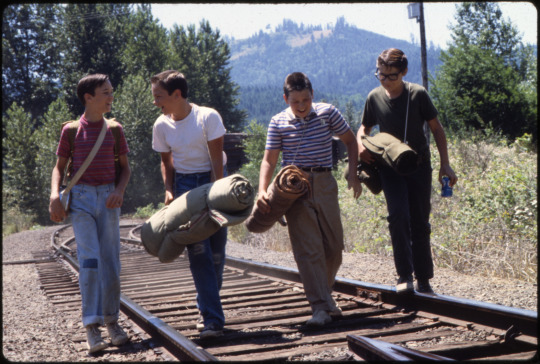
Double Feature — 1980s Coming-of-Age Films Starring Corey Feldman, Kiefer Sutherland, and Challenging Brother Relationships That Influenced Stranger Things: Stand by Me (1986) + The Lost Boys (1987)
Believe it or not, I had no idea these two ‘80s classics had so much in common when I chose to watch them back-to-back. In Rob Reiner’s adaptation of Stephen King’s Stand by Me (Crowd: 9/10 // Critic: 9/10), four kids (Feldman, Jerry O’Connell, River Phoenix, and Wil Wheaton) are following train tracks to find a missing body. In The Lost Boys (Crowd: 8.5/10 // Critic: 7/10), Corey Haim and Jason Patric move to a small California town and discover it’s full of ‘80s movie star cameos and…vampires? One is a thoughtful coming-of-age story and one is just bonkers, but both are a great time.
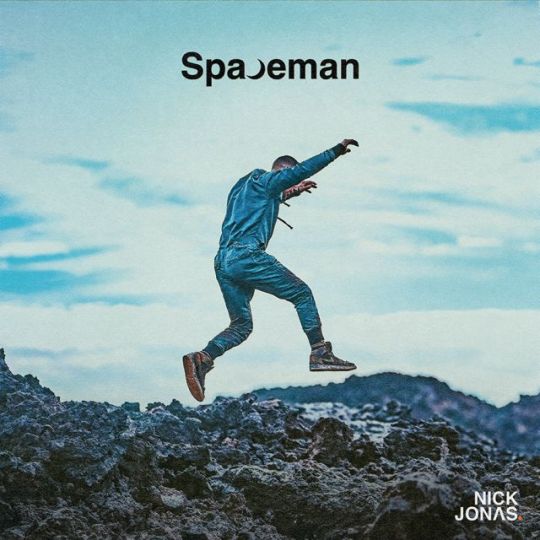
Spaceman by Nick Jonas (2021)
My love for the Jonas Brothers is well-documented, so instead of going down the rabbit hole I started digging at 15, I’ll talk about how Nick Jonas’s latest solo album will likely appeal to a wider audience than just the fans of the brothers’ bombastic pop records. It’s full of catchy tunes you’ll play on repeat and an R&B-influenced album experience about the loneliness we’ve experienced in the last year and how we try to make long-term relationships work.

Ted Lasso (2020- )
I love stories about nice people crushing cruelty and cynicism with relentless kindness, and Ted Lasso (Jason Sudeikis) is the warmest, most dedicated leader this side of Leslie Knope. Be sure to catch up on these witty and sweet 10 episodes before season 2 drops later this summer.
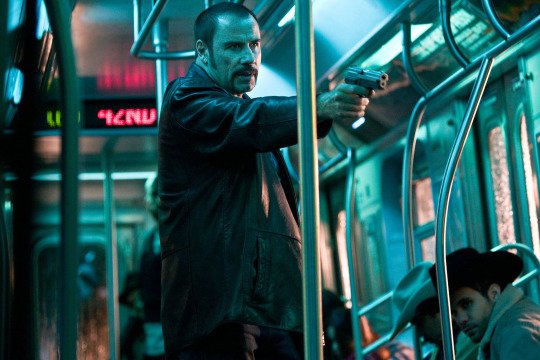
Double Feature — Tony Scott Action Flicks: Enemy of the State (1998) + The Taking of Pelham 123 (2009)
Tony Scott’s movies have got explosions and excitement in spades. I love a good man-on-the-run movie, and in Enemy of the State (Crowd: 9/10 // Critic: 8/10), Will Smith is running through the streets of D.C. after getting evidence of a politician’s (Jon Voight) part in a murder. I also love a tense story set in a confined space, which is what Denzel Washington is dealing with in The Taking of Pelham 123 (Crowd: 9.5/10 // Critic: 7/10) after a hammy John Travolta takes a New York subway train hostage.
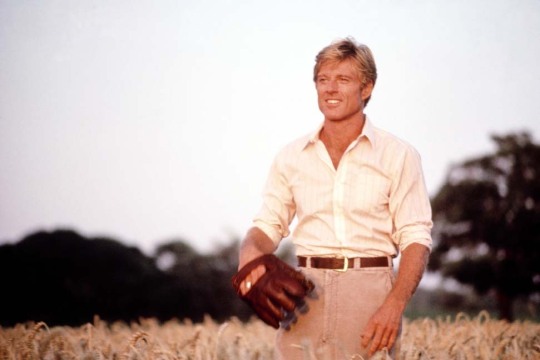
Double Feature — Baseball Movies: The Natural (1984) + Trouble With the Curve (2012)
Sue me—I love baseball movies. Robert Redford plays a fictional all-time great in the early days of the MLB in The Natural (Crowd: 8.5/10 // Critic: 9/10), and Clint Eastwood plays a fictional all-time great scout in his late career in Trouble With the Curve (Crowd: 8/10 // Critic: 7.5/10). If you love baseball or actors like Amy Adams, Glenn Close, Robert Duvall, and Justin Timberlake, these movies are just right here waiting for you.
youtube
Nate Bargatze: The Greatest Average American (2021)
Sue me—I enjoy Netflix standup comedy specials that are safe enough to watch with your whole family. That’s exactly the crowd I laughed with over Easter weekend, and while the trailer captures Bargatze’s relaxed vibe, it doesn’t capture how funny he really is.
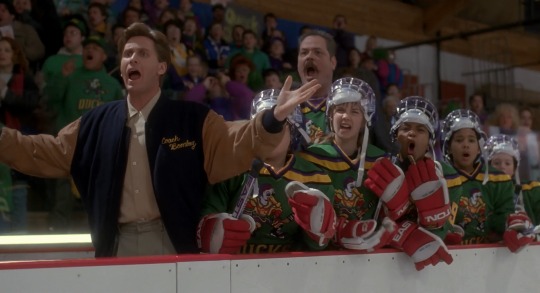
The Mighty Ducks (1992)
I thought somewhere in my childhood I’d seen at least one of The Mighty Ducks movies, but after watching all three, I think my memories must’ve come from previews on the VHS tapes for other Disney movies I watched over and over again. The original still holds up as an grown-ups, which is why even my parents got sucked in to this family movie while just passing through the living room. Bonus for ‘80s movies lovers: Emilio Estevez is basically continuing Andrew Clark’s story from The Breakfast Club as an adult. Crowd: 8.5/10 // Critic: 6.5/10

Double Feature — New, Dumb Action on Streaming: Godzilla vs. Kong + Thunder Force (2021)
If you want something intelligent, go ahead and skip to the next recommendation, but if you’re looking for something stupid fun, these are ready for you on HBO Max and Netflix. Thunder Force (Crowd: 8.5/10 // Critic: 6/10) follows Melissa McCarthy and Octavia Spencer as they train to become superheroes who take on superhuman sociopaths wreaking havoc on Chicago, and alongside Jason Bateman, they do it with a lot of laughs. Godzilla vs. Kong (Crowd: 9.5/10 // Critic: 5/10) is, um, exactly what it sounds like, so I’ll skip a plot summary and just say it’s exactly what you want from this kind of movie. #TeamKong
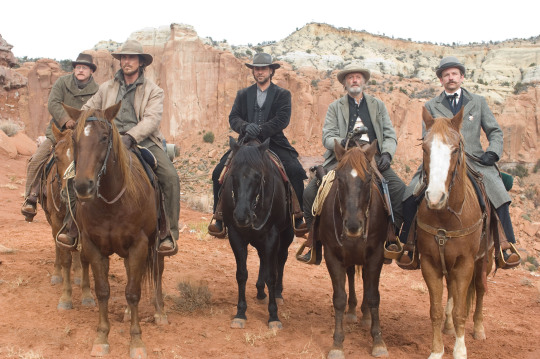
3:10 to Yuma (2007)
All you need to know is Russell Crowe is an outlaw, and Christian Bale is the guy who’s got to get him on the train to prison. I also watched the 1957 version, which is also a solid watch if you love classic Westerns. Crowd: 9/10 // Critic: 8/10
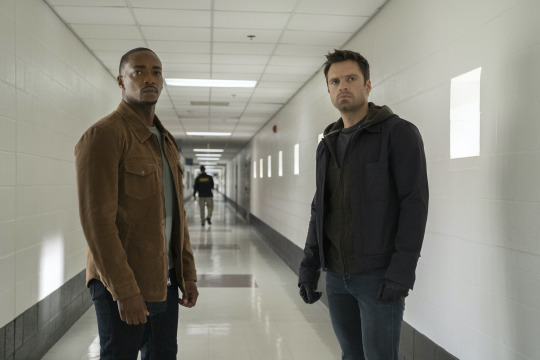
Falcon and the Winter Soldier (2021)
Marvel’s newest series isn’t nearly as inventive as WandaVision, and it may not land every beat, but it’s worth a watch for the fun new gadgets, Sebastian Stan’s dry joke delivery, and its exploration into themes of what makes a hero and what governments owe their citizens. It’s a pretty satisfying entry in the MCU canon, but I’d also recommend re-watching Captain America: Winter Soldier and Civil War—the canon is getting expansive, and it’s getting trickier every year to keep up with all the backstory.
March + April Critic Picks
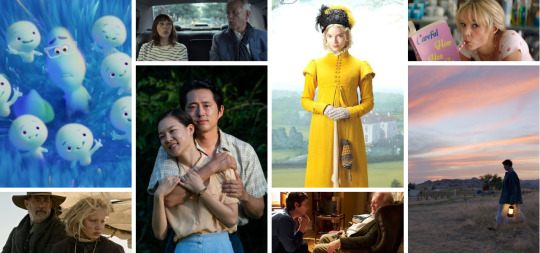
Best of 2020 Picks
As per usual, the months leading up to the Oscars becomes a binge period for potential Oscar nominees. In March and April, I watched many of the films that made my Top 20 of 2020, including Boys State, The Father, Judas and the Black Messiah, Let Them All Talk, Minari, Nomadland, On the Rocks, One Night in Miami…, Promising Young Woman, Soul, and Sound of Metal. You can read how I ranked them on my list for ZekeFilm, plus reviews of The Father, Minari, Promising Young Woman, and Soul.
Bonus: If you loved On the Rocks, don’t miss this feature and beautiful photography starring Sofia Coppola, Kirsten Dunst, Elle Fanning, and Rashida Jones for W Magazine.
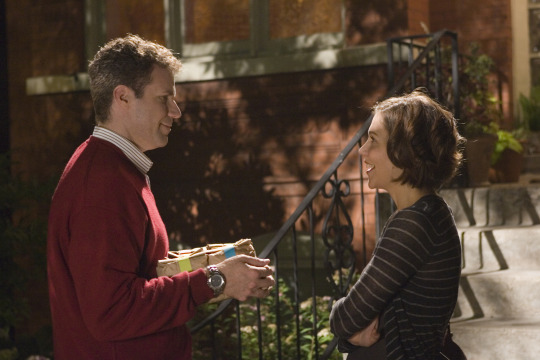
Stranger Than Fiction (2006)
What would you do if you started hearing a voice who narrated your every thought and move? If you’re Will Ferrell, you’ll seek out a literary professor (Dustin Hoffman), fall in love (with Maggie Gyllenhaal), and track down the voice (Emma Thompson) who’s making ominous predictions about your future. Stranger Than Fiction is funny thought-provoking, and an unusual but welcome role for Ferrell. Crowd: 9.5/10 // Critic: 9/10
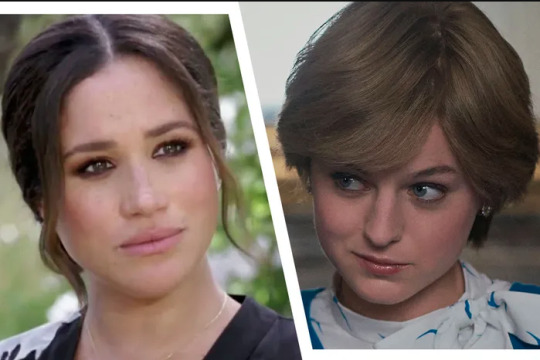
All the Royal Family News
Speaking of stranger than fiction, it’s been a busy few months for the Royal Family. We’ve celebrated 95th birthday of Queen Elizabeth, the 3rd birthday of Prince Louis, and the 10th anniversary of Will and Kate’s marriage. We also lost Prince Philip, and we watched the drama of Harry and Meaghan’s interview with Oprah. No matter what happens to their Crown, I don’t think we’ll ever get over our fascination with the Windsor family. A few pieces worth reading from the last few months:
“In Meghan and Harry’s Interview, Two TV Worlds Collided,” Vulture.com
“The Queen’s Man: Philip, Duke of Edinburgh, Dies,” TIME.com
“Obituary: HRH The Prince Philip, Duke of Edinburgh,” BBC.com
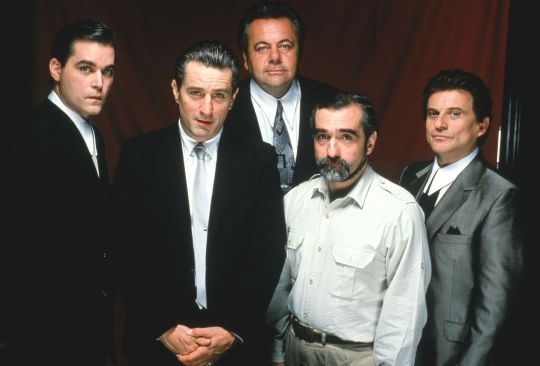
Goodfellas (1990)
One of my film opinions that makes me feel like a phony is that Martin Scorsese just isn’t my cup of tea. He’s brilliant, but his films tend to be long and dark, two qualities that are never my first choice…and somehow Goodfellas still worked for me? Maybe it was the TV edit graciously toning down the violence or maybe it was that Ray Liotta and Joe Pesci were firing on all cylinders, but for some reason this ‘90s classic didn’t suck the joy out of my evening like Scorsese often does. (Bonus: For a Martin Scorsese/Robert De Niro I don’t really recommend, head to the last section of this Round Up.)
youtube
Fearless (Taylor’s Version) (2021)
Her voice has only matured, so Taylor Swift revisiting her old albums is like upgrading a blast to the past. Plus, the six new tracks make me feel like 15 crushing on that boy in Spanish class again, and her Grammys performance (just before her third Album of the Year win) was magical and folklore-tastic.
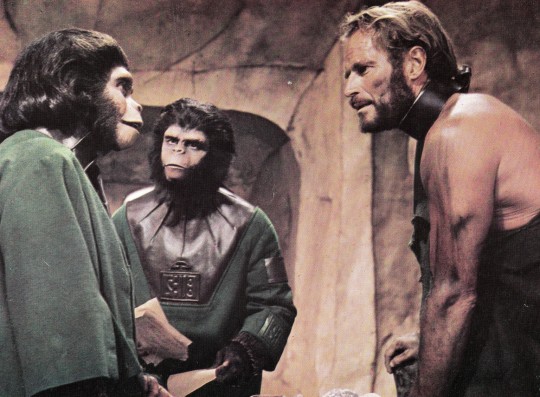
Double Feature — ‘60s Action Classics: The Guns of Navarone (1961) + Planet of the Apes (1968)
The Guns of Navarone (Crowd: 8/10 // Critic: 8.5/10) follows Gregory Peck and David Niven as they destroy Nazi weapons in the Mediterranean. Planet of the Apes (Crowd: 8/10 // Critic: 8.5/10) follows Charlton Heston as he attempts to escape from, well, a planet full of apes. The pacing of ‘60s films doesn’t always hold up, but that’s not the case with this pair. Both are still full of suspense, and you can’t go wrong hanging with casts like these.
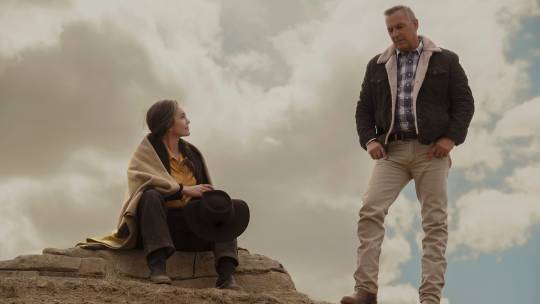
Let Him Go (2020)
Kevin Costner and Diane Lane play a farming couple who unexpectedly help raise a boy who lost his biological father—sound familiar? But instead of a superhero origin story, they’re part of a thrilling Western with performances nuanced (Costner and Lane) and showy (Lesley Manville). If I’d watched this before completing my Best of 2020 piece, it likely would’ve been on my list. Crowd: 8/10 // Critic: 8.5/10
youtube
The Oscars
I’m a ride-or-die fan of the Academy Awards, but I’ll admit even I found this year’s ceremony odd. Instead of focusing on what wasn’t so hot, I’ll recommend a few moments you don’t want to miss:
Emerald Fennell giving a shout-out to Saved by the Bell
Daniel Kaluuya acknowledging his parents’ sex life during his acceptance speech (??)
Yuh-Jung Yoon flirting with Brad Pitt and acknowledging she’s just “luckier” than her fellow nominees
Glenn Close dancing to…”Da Butt”?
You can also read about the historic wins and nominations from this year’s Oscar class and why the Golden Globes were an even stranger production weeks earlier.
youtube
Trailer-palooza!
Movies are on their way back, y’all! I’m counting down the days until I can get back to a theatre, and even if some of these movies are duds, I’m planning to see all of them on a big screen if possible:
Those Who Wish Me Dead (May 14)
Cruella (May 28)
In the Heights (June 11)
Space Jam 2 (July 16)
Shang-Chi and the Legend of the Ten Rings (September 3)
West Side Story (December 10)
Also in March + April…
To add to the Oscars love, you can listen to a conversation about what we learn about family, community, and society in some of the year’s biggest nominees on the Uncommon Voices podcast. I join regular hosts Michael and Kenneth in this episode, and I recommend all of their thoughtful discussions on their “What’s Streaming” episodes.
I’ve previously recommended the Do You Like Apples weekly newsletter, so I’m proud to share I contributed twice in March! I wrote about Love and Basketball, directed by Gina Prince-Bythewood, and one of my all-time favorite Julia Roberts rom-coms, Notting Hill. (I also tied to win their Oscars pool, but I suppose that’s less exciting for you than me.)
It was a busy couple of months on SO IT’S A SHOW! New logo, new email list, new Instagram, and a host of new episodes about a flop of a Madonna flick, a Swedish children’s TV show, an urban legend turned into a horror movie, one of the best films about journalism ever, and a Martin Scorsese movie about a real boxer.
Most of what I wrote for ZekeFilm in March and April was mentioned in Best of 2020 recommendations…except for The Nest, a film that couldn’t figure out what genre it wanted to be.
Photo credits: Nick Jonas, Royal Family. All others IMDb.com.
#Round Up#Bad Times at the El Royale#Den of Thieves#Caddyshack#Splash#Stand by Me#The Lost Boys#Spaceman#Nick Jonas#Ted Lasso#Enemy of the State#The Taking of Pelham 123#The Natural#Trouble With the Curve#Nate Bargtze#Nate Bargatze: The Greatest Average American#The Mighty Ducks#Godzilla vs. Kong#Thunder Force#3:10 to Yuma#Falcon and the Winter Soldier#Stranger Than Fiction#The Royal Family#Meaghan Markle#Prince Harry#Goodfellas#Fearless#taylor swift#Fearless (Taylor's Version)#The Guns of Navarone
13 notes
·
View notes
Photo
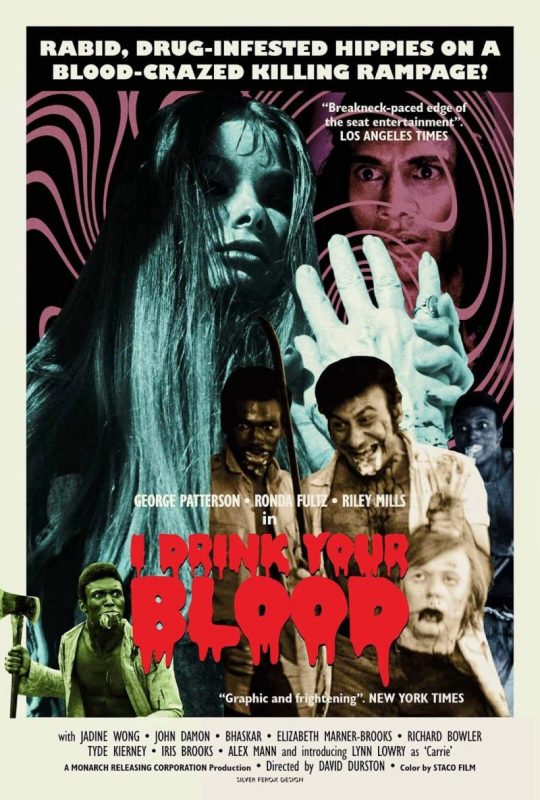
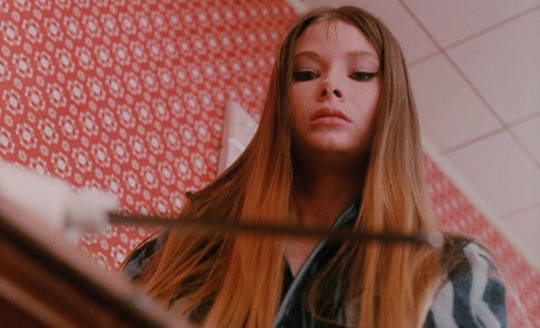



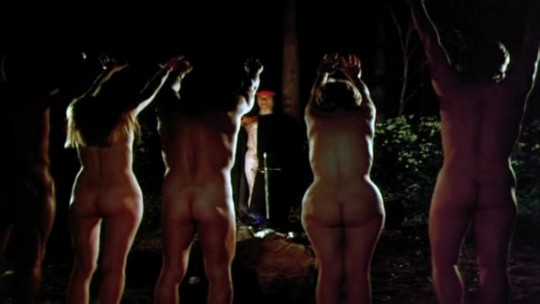
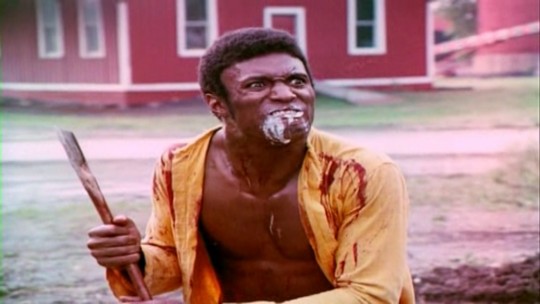
I Drink Your Blood (1971) full review
Published by grimoireofhorror.com 13/01/21
B-movies have become a staple in popular culture over the recent years, with cult classics from the 1970s and 1980s finally receiving the wider attention they rightly deserve. One such classic piece of media that has garnered attention is I Drink Your Blood.
I Drink Your Blood (1971) is an exploitation film directed by David Durston, who has only directed a total of 7 films from 1964 to 1978, including Stigma (1972) and produced by Jerry Gross, who has work on a number of well-known films such as Zombie Flesh Eaters (1979) (or Zombi 2, depending on where you are from).
*This review contains spoilers
The film opens to Horace, the leader of a roaming cult of satanic hippies, performing an occult ritual in the woods outside of a small town, when a young girl, Sylvia, is noticed observing the group, but Andy, a young man, who she had caught stealing a chicken in the afternoon and befriended, tries to defend her. The rest of the group give chase and attack her, beating her mercilessly. After managing to make her way back into town the next morning, she is found traumatized by her younger brother, Pete, and Mildred, the towns baker, who take her home to her grandfather, the local vet.
After their van breaks down, the cult has no choice but to make their way into town for supplies. They buy food from Mildred, who is unaware of what has transpired, who lets them know that the town is scheduled for demolition and they can stay in a vacated house for the night.
After Sylvia overcomes her state of shock, she tells her grandfather what has happened and he confronts the cult, only to be beaten and force-fed LSD. As Horace is about to kill the old man, the cult members convince him to stop as Pete arrives outside, demanding to know what is going on. Angered by what the cult did to his family, Pete hatches a plan of revenge by obtaining tainted blood from a rabid dog to lace food to sell to the cult.
After eating the contaminated food, except for Andy, who refuses to eat, the cult starts to show signs of infection and exhibit violent behaviour, causing some of them to flee into the night. One member of the group is picked up by construction workers from the local dam, who take her back to their lodgings to calm down, she proceeds to have sex with a few of the workers and infect them. Roger, head of site construction and Mildred’s boyfriend, discovers his workforce are now all infected with rabies and is chased, along with the local doctor, down to a lake filled quarry but their assailants are scared away by the water that has collected.
The remaining members of the cult attack each other in what remains of the town whilst Pete, Sylvia and Andy, who has expressed regret for what had happened to Sylvia, try to find a means of escape. The group find Mildred hidden inside the bakery, but as they are let inside, Andy is attacked and killed by a rabid construction worker and the store is breached but Mildred manages to kill one as they escape outside to her car. Surrounded by Rabid workers and cultists, the car is flipped over and all looks lost until a group of armed police, led by Robert, gun down the remaining infected and save the trio from harm.
The film was originally title Phobia but was changed after production to be more fitting for a double feature and renamed I Drink Your Blood to be paired with I Eat Your Skin, a film that went by the name Zombie and was shelfed for 6 years before Jerry Gross obtained the rights to release the film under this double feature.
The film was the first to receive an X rating for violence alone and was re-edited and scenes reshot to receive a M rating and a cinema release. It is rumoured that David Durston based the character of the cult leader, Horace, on actual cult leader Charles Manson, who was made famous for ordering his cult to go on a killing spree in 1960’s California. With the film being marketed and released a year after Manson’s conviction, Jerry Gross wanted to cash in on the public’s fascination and disgust with the case. In 2009, David announced that he planned to remake the film, which he had started work on the films script, unfortunately, David’s death in 2010 has causes the project to be permanently shelved.
The cinematography is fairly competent but has many scenes where crew members are visible making them feel somewhat rushed in production. The use of its soundtrack adds both tension and unintended comedy to certain scenes, composed by Clay Pitts, the synth heavy soundtrack being atmospheric and unsettling in some scenes but becomes hilarious during chase scenes. The practical special effects are very well done for such a small budget and hold up 50 years later, with great blood work and realistic props, it’s one of the films core strengths. I’m not going to lie; this film was never going to win any awards. With a fine mix of over and under acting by the cast of relatively unknown actors, a campy exploitation story and unique 70’s soundtrack, this film falls perfectly into the category of “so bad its good”, and my is it good.
Despite all this, the film has positive to mixed reviews from critics and is a beloved cult classic, having similar characteristics to later classics as David Cronenberg’s Rabid (1977) and George A Romero’s The Crazies (1973) and has been shown at frequently at film festivals over the years, helping cement its place in popular culture.
#writing#writers on tumblr#journalsim#journal#review#exploitation#film#b movies#i drink your blood#gore#zombies#the banshee#grimoire of horror
9 notes
·
View notes
Text
James Bond conquers Czechoslovakia (or not?)
In the sixties, James Bond was everywhere. But even though it was a big worldwide phenomenon, it was hardly accessible to everyone. Czechoslovakia was a socialist country with a strict regulation system for film industry, so it is not surprising that James Bond films were not screened until the end of communist regime in the early nineties. But somehow James Bond had a notable presence in Czechoslovakia. It was a name known to average film fans. They heard about Sean Connery, Bond girls, and some of them could describe a detailed plot of the movies. How is it possible? This article discusses media discourse about James Bond, and how it created a basis for a familiarization with the James Bond film franchise.
The Czechoslovak film industry was centralized in the state-controlled institution between 1945 and 1990. Every imported film was approved by the state. Very broadly speaking, genre cinema from the Western countries wasn't ideologically desirable. Only around 5–10 British films were screened every year in Czechoslovakia in the '60s and '70s . Mostly they were kitchen sink dramas (A Taste of Honey or Saturday Night and Sunday Morning) or literary adaptations (Tom Jones, Far from The Madding Crowd). The action adventure genre was presented by French comedies (super popular Fan-Fan the Tulip and similar films) and by French art films (Breathless, Pierrot le fou). Important were leftist qualities of these movies. Approved were also some James Bond knock-offs, for example West German movies about FBI agent Jerry Cotton. Some people would say that James Bond and similar films could not be shown because of censorship, but that is not true. These films were not screened, because they just were not bought into the Czechoslovak distribution. There were, of course, reasons for that.
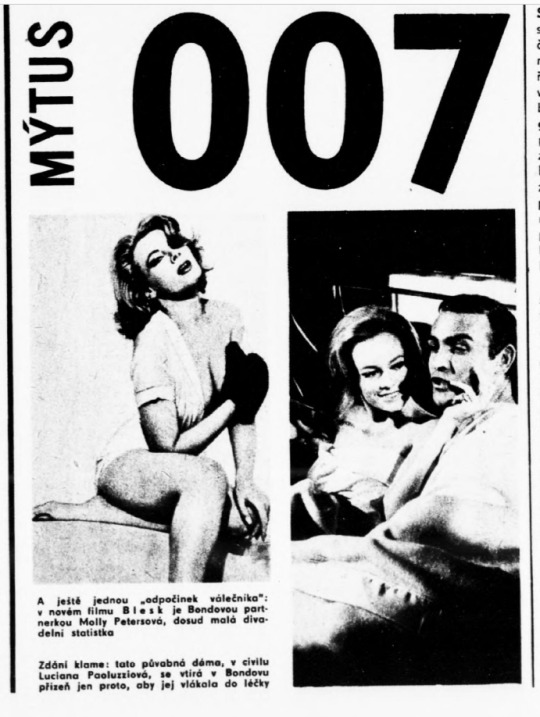
So what exactly was problematic in James Bond films? First, it was simply a country of origin. It was not just that Bond was British (= Western country). In Czech press were Bond movies often described as American, which is at least partly true: distribution rights were owned by the American company United Artist. Also values presented by the films were values that were in Czechoslovakia identified with capitalist countries, especially with the United States. But mostly, Bond wasn't a preferred type of a hero for a socialist audience. He was rich, obsessed with expensive cars and clothes, violent and sexual. He was not nice. He was not a socialist hero. A Polish film historian Jerzy Toeplitz wrote about a bad influence of James Bond books and films, and the article was translated for Panoráma zahraničního filmového tisku in 1966. He wrote that James Bond books are meant for a Western reader who is “succumbed to the amuck of accumulating consumer goods.” That is related to the fact that the film series itself was perceived as existing just with a goal of gaining money. A lot of articles were stating (and mocking) the way the films were used for merchandise.
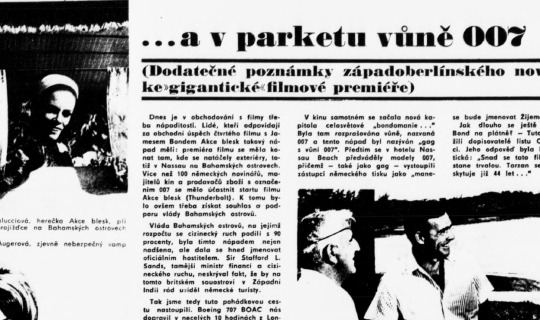
James Bond was a perfect picture of a capitalist country: cruel, brutal, too erotic, sadistic and racist. Which are all fair points, but they weren't said with an aim to open any kind of discussion. The goal was purely ideological. “We must build a hero – either a man or a woman of our time who upholds our humane socialist morale – and pose him or her against this mythical hero who can do anything, nothing is a nuisance to him, who overcomes everything smoothly and – like James Bond, for example – has the right to commit senseless murders. This represents an ideological conflict with the bourgeoisie, one that is essential and without compromise.” (Film a doba, 5, p. 243).
Perhaps the most interesting aspects were constant mentions about racism. However a language that was used to describe racism in James Bond films was very racist itself. That is actually not surprising because Czechoslovak people had – and still have – lots of racist issues. Lubomír Oliva, one of prominent Czechoslovak film critics, described James Bond this way: “James Bond embodies a new type of Superman. He is coldy cruel and dismissive of the weak. He kills without remorse, because that is his job. Multiple scenes from the trilogy show racism, which is subconscious, automatic, and therefore more insidious. Is he the Tarzan among nuclear weapons? Or perhaps he is a different but more dangerous type of a primitive: a close relative of the Nazi Übermensch.” (Kino, 1965/11, p. 13). It is also very telling to look closely at the photos used in that article – Bond shoots, Bond fights, Bond smiles like a crazy lunatic while he kills people. The writing itself is very suggestive, evocative and even vulgar. Oliva loves to mention every specific and cruel thing Bond does in the films in details. One has to ask – what if the effect of listing all the bad things was quite opposite? Was not public more curious to watch it?
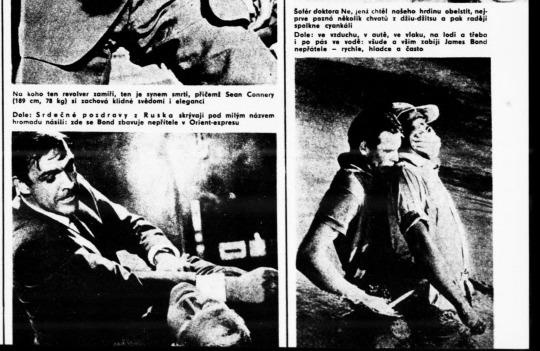
Maybe the screenwriter of many amazing Czech genre films (Adela Has Not Had Her Supper Yet, Lemonade Joe) Jiří Brdečka was a little bit fond of Bond, right? Well – not really. The most problematic part of Bond films, according to Brdečka, was their anti-communist aspect. A majority of the villains were communists and often from USSR, which was not acceptable. In Brdečka's article in Divadelní a filmové noviny he compared people of color to communists. James Bond films are full of prejudice against both, and that is simply bad. He also wrote: “This hero is deeply engaged and his engagement compels him to eat communists and colored people for breakfast – both at the same time if possible. This tells us that James Bond may not find fertile soil around these parts.” But Brdečka at least acknowledged that the films were really well made. And concluded with: “[The films] are excellent crap, with an emphasis on crap.” (Divadelní a filmové noviny, 1965/9-10, p. 10). Galina Kopaněva (another a very prominent and very popular film critic) took one step further. Not only the films themself are bad and stupid, the loving audience from Western countries is stupid as well: “[young people] devour the elegant Bond and his precise punches to the stomach. They loosen their ties a la Bond when they see the closeups of of Bond girls’ super-breasts, they bray with enthusiasm when there is an especially well done murder, they clench their fists as they watch crazy car chases on serpentine mountain roads, and they succumb to the pleasant shivers caused by torture scenes.” (Film a doba 1965/6, p. 323). The infantilization of audience was sometimes used while describing popular culture but was not broadly used for describing James Bond.
So, now we know that James Bond was bad for Czechoslovak people. Or at least according to the prominent film critics and state-run film industry. But how is possible that James Bond became a well known phenomenon in communist Czechoslovakia? It was not allowed to show James Bond in the cinemas but somehow people knew who James Bond is. There were also special namings for James Bond films – bondovky (that is used still today) and bondiády. People were obsessed with them, even though they did not have an option to watch them.
The most obvious answer for James Bond popularity is that he was a constant presence in the Czechoslovak film press. He was – in his invisibility – totally visible. Bond films were often mentioned (and sometimes analyzed) in the press targeted towards film professionals (Interpressfilm) or “smart” film fans (Film a doba, Divadelní a filmové noviny) and in popular film magazines (Kino). Almost every Czechoslovak film critic had an opportunity to see a James Bond movie at some international film festival or in a cinema abroad. That means that they wrote reviews for Czechoslovak magazines. But the reviews were not only about qualities of the films. More often the critics retold the plot with every possible detail (including the ending of the film). The magazines also published spreads about James Bond phenomenon in general (including lots of photos), interviews with actors or directors, short notes about upcoming films or about changing of the actors. The articles were a weird mixture of positive and negative. For example, you would have a long text about Sean Connery, and in this article author would write about how wonderful actor Connery is. But they would also mention that Connery deserves better than Bond. Or you would have a big spread about a James Bond movie premiere, and author would mention that film is spectacular and fun to watch, but also that it is still a low and decadent film.
Another way to get familiar with James Bond were the books by Ian Fleming. Three of them were published in Czechoslovakia: Dr No (Doktor NO, 1968; both Czech and Slovak version), View to a Kill (collections of short stories Ve jménu zákona, 1969) and Goldfinger (Zlatý fantóm, 1970, with a film cover and a lot of photos inside the book). The rest of the stories was published after 1990.
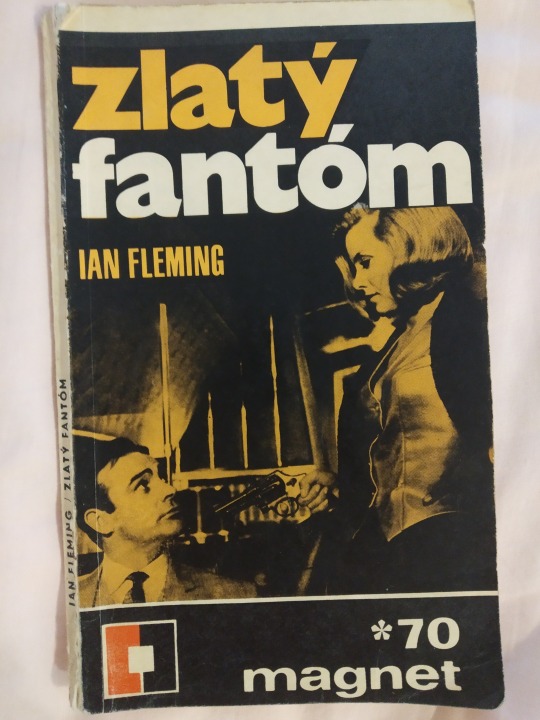
Of course in Czechoslovakia were some people that managed to see a James Bond film in other countries (travelling was complicated but not absolutely impossible). Ivan Soeldner said that people used to visit strip clubs while abroad, but suddenly it was a necessity to go see a James Bond film instead. He also stated that Bond (and strip clubs) are highly overrated (Kulturní tvorba, 1965/33, p. 14). But Bond films became word of mouth sensation – not just because they were entertainment films but because what they meant. Bond films were in a way similar to popular American music or Coca-cola. People heard so much about it that it became its own animal. The efforts to minimize and ridicule Bond in press actually created by mistake an unique mythos of James Bond – almost a symbol of anti-sovietism and anti-communism, something like a forbidden fruit.
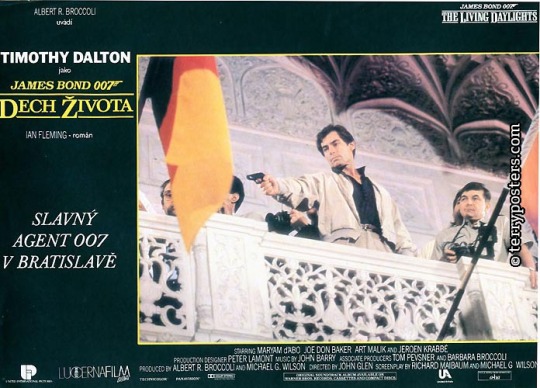
James Bond obsession calmed down a little bit with a departure of Sean Connery. Some articles were still occasionally written but not with so much passion as it used to be in the '60s. But a new opportunity to see James Bond films arrived to a Czechoslovak audience in the '80s. Videorecorders became more affordable and in 1985 there were around 80 000 of them. For Czechoslovakia was a very important phenomenon an unofficial “pirate” dubbing. So suddenly, for some people was a possibility to borrow VHS with some movies that were unavailable before (including Bond films).
The communist regime ended in Czechoslovakia in 1989 and Czechoslovak film industry started to transform. The process was slow and messy. But finally, a first James Bond film was shown in Czech and Slovak cinemas: The Living Daylights in 1992 (in English original with Czech or Slovak subtitles). This film also had a special bonus for the viewers – it took place in Bratislava, Slovakia (but it was actually filmed in Austria). A lot of older Bond films also appeared in official VHS market, and the “black pirate market” was still quite proficient during the nineties.
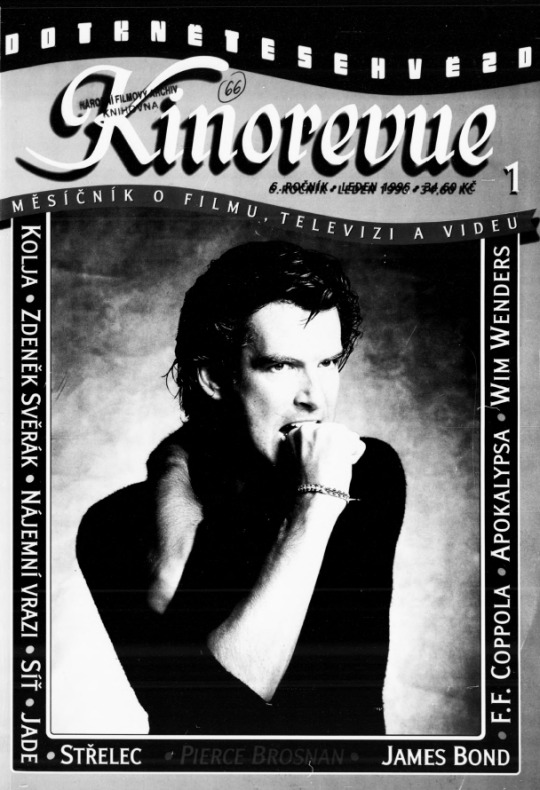
The aim of this short overview was to show the ways James Bond appeared in the Czechoslovakia for the first time. It was probably very similar in other socialist countries (Poland, USSR,…). I think that it is important to ask questions about what Bond actually meant for a different types of audiences, and how it changed over time. The answers are still relatively vague (and maybe even banal), more answers could bring complex research in daily press or oral history.
My sources: I did a quick research using a lot of articles from the '60s till early '90s. Big thanks to National Film Archive that has everything scanned in the digital library.
Periodicals: Divadelní a filmové noviny, Film a doba, Filmové aktuality, Filmové informace, Filmový přehled, Interpressfilm, Kino, Kinorevue, Kulturní tvorba, Panoráma, Panoráma zahraničního filmového tisku, Záběr
I also used my own knowledge of Czechoslovak film industry (so you need to trust me that it is all true). I tried to put all this together, and the conclusions are my own. Hopefully, it all makes sense (I didn’t went too much into details because well, this is not some kind of complex research, it is just something I did for fun)
And thank you to amazing @slippingintostockings who helped me with the translation of Czech reviews from the sixties.
#007 fest#007 fest 2020#teamcivilian#meta#james bond#classic bond#sean connery#czechoslovakia#čumblr#I's not so boring how it sounds I promise!#maaaybe just a little bit#it's niche#but I really wanted to write this#mine
27 notes
·
View notes
Photo
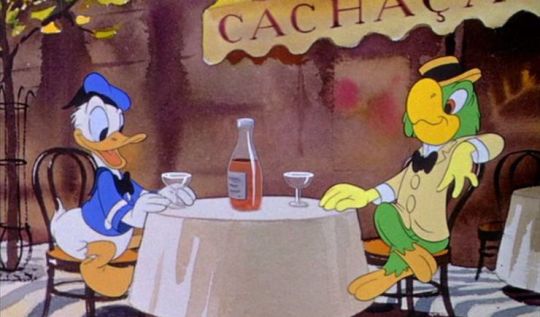
Saludos Amigos (1942)
In the wake of the Disney animators’ strike and the end of the studio’s Golden Age with Bambi (1942), Disney’s industry rivals and the upstart United Productions of America (UPA) stood to benefit from the terminations to come. After seizing control of Fleischer Studios from Max and Dave Fleischer, Paramount set up Famous Studios – against the Fleischers’ sensibilities, Famous Studios doubled down on appealing to children while continuing the Popeye the Sailor and Superman short film series. But Metro-Goldwyn-Mayer (MGM) and Warner Bros., though neither were making animated features, had most to gain from Disney’s misfortune. MGM would pool its resources into self-referential, highly suggestive short films that could never exist under the Disney banner. The works of William Hanna, Joseph Barbera, Fred Quimby, and especially Tex Avery flourished. Under MGM, Barney Bear, Droopy, and Tom and Jerry became part of the American animated canon.
Elsewhere in Burbank, Leon Schlesinger Productions, partnered with Warner Bros., became Disney’s crosstown antithesis. Schlesinger, as arrogant a person as Disney was socially awkward to his employees, harbored no illusions that Merrie Melodies and Looney Tunes could ever compete with the sheer artistry of Disney’s Golden Age features and its Silly Symphonies. Fostering the talents of Chuck Jones, Friz Freleng, Tex Avery (before his defection to MGM), Bob Clampett, and Robert McKimson, Warner Bros. – in a studio as ratty as Disney’s was pristine – operated anarchically. In this culture spawned a style that leans into anything that might make an audience laugh. No matter how outrageous a proposed story’s premise or behavior, Schlesinger would not be one to say “no”*. Take the characteristics of Mickey Mouse and friends and maximize them. As a result, you have the wiseassery of Bugs Bunny and Daffy Duck, the situational ineptness of Porky Pig and Wile E. Coyote, and the dimwittedness of Elmer Fudd. Warners’ films had a disorderly, unrestrained (and sometimes callous) energy that Disney’s animators were on record of being envious towards.‡
Disney’s animators wanted to channel some of this mania into their next two films: Saludos Amigos and The Three Caballeros (1944). Both films are the result of Walt Disney’s 1941 goodwill trip to Brazil, Argentina, Chile, and Peru, organized by the United States Department of State. The United States was concerned that South American nations might sympathize, if not outright ally with, the Axis. Thus, the federal government offered loan guarantees to Disney’s financially struggling studio if Walt would partake on the tour. Walt agreed, with an ulterior motive – he could leave his brother Roy and studio counsel Gunther Lessing to handle the post-strike wave of layoffs. With Norman Ferguson, Wilfred Jackson, Jack Kinney, Hamilton Luske, and Bill Roberts as supervising directors, Saludos Amigos is the first of the Disney “package films”, and the result of vastly conflicting interests. It is an inconsistent film, its comedy overshadowed by the Looney Tunes series, and the first non-masterpiece Disney animated feature after five inspiring triumphs.
Saludos Amigos is barely a feature film, clocking in at forty-two minutes (the Academy of Motion Picture Arts and Sciences, the American Film Institute, and the British Film Institute all define a feature as a film longer than forty minutes). As such, the movie is essentially a selection of four glorified, narratively unrelated short films. Also included is behind-the-scenes footage of Walt Disney’s entourage (“El Grupo”; including Walt, Lee Blair, Mary Blair, Norman Ferguson, and Frank Thomas) to transition between segments. In order, the segments are: “Lake Titicaca” (Peru), “Pedro” (Chile), “El Gaucho Goofy” (Argentina), and “Aquarela do Brasil” (Brazil).
Beginning with “Lake Titicaca” – named after the eponymous lake on the Peruvian-Bolivian border – the film opens with a Donald Duck short. In the years just before Mickey’s appearance as the sorcerer’s apprentice in Fantasia (1940), Donald Duck had briefly overtaken Mickey Mouse in popularity. After the Japanese attack on Pearl Harbor, the studio enlisted Donald Duck to be the center of its World War II propaganda – it would be hard to imagine Mickey Mouse going to war. Donald’s appearance in “Lake Titicaca” is a rare non-propaganda outing for the barely understandable duck. It just so happens to also be a lazy Donald Duck short. The best Donald Duck shorts exploit his infamous temper – gradually. Instead, Donald is subjected to what amounts to a travelogue where his tourist’s mentality occasionally endangers him. Though it may not be the prototypical Donald Duck piece, the segment adds nothing to his characterization. The narrator reveals brief, exotifying factoids that could not have played well to a presumably Latin American audience – something that colors the rest of this film.
Next up is Peru’s Andean neighbor, Chile. “Pedro” follows the daring of the anthropomorphic mail airplane of the same name and packs in a lot of storytelling in just several minutes. Pedro, the child of Papá Plane and Mamá Plane (wait, some will say – planes don’t grow as they age!), is tasked to deliver the mail across the Andes when Papá comes down with a cold. Why doesn’t Mamá Plane fly the mail? “High oil pressure” – but knowing the boys’ club that was the Disney studios of this era, that probably isn’t the real reason. Pedro must brave the turbulence as he ascends over the Andes, and especially as he nears Aconcagua. At 22,837 feet (almost 7,000 meters), Aconcagua is the tallest mountain outside Asia – and with a mountain of that size, it invariably creates its own unpredictable weather.
Flight in the 1940s was still a relatively risky proposition, and “Pedro” captures this during the stormiest sequences that define its closing minutes. As the most inspired moment not associated with “Aquarela do Brasil”, these moments are made possible due to the special effects honed in during previous Disney animated features and a crashing sound mix that sells the danger that Pedro faces. To its credit, this second chapter of Saludos Amigos feels the most like a potential feature film that went unrealized. “Pedro” does not suffer as much from exotified elements in comparison to other segments in Saludos Amigos. But nevertheless, it inspired Chilean cartoonist René Ríos Boettiger (“Pepo”) to create the character Condorito, a comic strip condor whose adventures are read widely across Latin America.
In Argentina, we find “El Gaucho Goofy”. This third part adopts the tone and style of the How to… series (1944’s How to Play Football, 1950’s How to Ride a Horse) featuring Goofy. It might as well be entitled “How to Be a Gaucho”. The omnipresent narrator imparts culturally specific terms and Gaucho equipment that spontaneously appear for Goofy to react to. As always, the narrator is moving too fast for poor Goofy, who can barely keep up. This is hilariously subverted in the scene where Goofy is pursuing a rhea (a distant relative of the ostrich) while on horseback. A fast rewind occurs, and the scene is played back in slow-motion. But it is obvious that the scene has been re-animated in slow-motion and the narrator has also recorded his lines to fit the hilarity on-screen. This is a hysterical touch and a rare (and effective) instance of a mid-century Disney movie breaking out metatextual jokes. “El Gaucho Goofy” also boasts Argentinian artistic input – illustrator/painter Florencio Molina Campos served as consultant for this segment, The Three Caballeros, and Fun and Fancy Free (1947). Campos’ style (muted colors and an emphasis on the Pampas’ skyward horizon) and preferred subject material (life on the Argentinian Pampas for Gauchos and their families) are apparent across “El Gaucho Goofy”. The segment undoubtedly benefits from his influence.
Moving north, the film ends with “Aquarela do Brasil” (“Watercolor of Brazil”). The segment is framed by an extended cover of the song of the same name composed by Ary Barroso and sung by Aloysio Oliveira – the song was popular in Brazil at the time, but Saludos Amigos vaulted the composition to international fame . Easily the most abstract of the four Saludos Amigos chapters, it also adopts a conceit later replicated in Chuck Jones’ Duck Amuck (1953) in which the background, foregrounds, and characters are painted by an artist’s brush onto a previously blank canvas. “Aquarela do Brasil” features Donald, but also marks the debut of the cigar-smoking, samba-dancing parrot, José Carioca. José (pronounced with a hard “J” in Portuguese) is Donald’s fun-loving foil dressed in malandro attire, but this clash of personalities will not be as apparent until The Three Caballeros. Following the interruption of José’s introduction, the film resumes with its splashy, colorful, romanticized abstractions of what life in Rio de Janeiro is like. It is the better and more aesthetically interesting Donald Duck short film when compared to “Lake Titicaca”, if mostly because José Carioca is a scene-stealer.
If the transitions between the descriptions of the four segments in this review feels abrupt, that is because there is little to no transition between the four segments of Saludos Amigos. Each segment is a hard reset after the last, and the supervising directors make no attempt to establish any linkages between them. It results in pacing issues that make “Pedro” – the most narrative-dependent of the four – feel much longer than it is.
When released in the United States, Saludos Amigos surprised American viewers. For many, the film upended their preconceptions of Latin America as a dour, unfashionable, and backwards place. Americans – rarely regarded as being worldly people – who saw Saludos Amigos more positively viewed their southerly neighbors. For Latin American audiences, interest in American culture, already deeply immersed in Hollywood movies, solidified. But for the Latin American governments in power during World War II and after, Saludos Amigos and The Three Caballeros’ intended aims had a muted effect – especially in Argentina, which waffled between the Allies and Axis due to its historic rivalry with Great Britain and its sympathies to Nazi Germany.
With a muted reception, Saludos Amigos begins the package era of films within the Walt Disney animated canon. For the next few years, Walt Disney and his animators would be making mostly propaganda short films for the United States government. These propaganda works helped stabilize the studio’s finances, if nothing more, and reflected Walt’s increasing political conservatism. His turn to the Republican Party for the remainder of his life was not due to long-held political convictions, but the outsize influence of studio counsel (and hardline anti-communist) Gunther Lessing on Walt’s political opinions. Walt Disney’s artistic soul would rarely surface over the next few decades, following the bitter disappointment of how the later Golden Age animated features were treated by audiences and critics. In the meantime, the Walt Disney Studios in Burbank kept their focus on fulfilling government requests for propaganda pieces, and now resembled more of an industrial factory than the happy, extended artistic family Walt had once sought.
My rating: 5/10
^ Based on my personal imdb rating. Half-points are always rounded down. My interpretation of that ratings system can be found in the “Ratings system” page on my blog (as of July 1, 2020, tumblr is not permitting certain posts with links to appear on tag pages, so I cannot provide the URL).
For more of my reviews tagged “My Movie Odyssey”, check out the tag of the same name on my blog.
* Even Schlesinger’s successor, Edward Selzer (who took control in 1944 when Schlesinger sold the studio to Warner Bros., renamed “Warner Bros. Cartoons, Inc.”) – described by Chuck Jones as humorless and more intervening – came to respect the instincts of the animation directors and gag men.
‡ Disney animator Dick Huemer on Warner Bros. animated shorts: “It was like admiring the kind of dame that you couldn’t introduce to your mother.”
#Saludos Amigos#Walt Disney#Norman Ferguson#Wilfred Jackson#Jack Kinney#Hamilton Luske#Bill Roberts#Lee Blair#Mary Blair#Donald Duck#Jose Carioca#Goofy#Disney#My Movie Odyssey
15 notes
·
View notes
Text
10 Shortcuts For Today Accurate Football Prediction That Obtains Your Lead To Document Time
Genuine Madrid Head Of State Backs Soccer Modifications Article.
Shared ObjectsDiscourage sharing of things that are tough to clean, disinfect, or decontaminate. Do not let players share towels, apparel, or other items they utilize to wipe their faces or hands.
Pleasant to a mistake, Million Buck Arm is a middle-of-the-plate pitch that drifts on Jon Hamm's considerable charm without including any really initial curves to Disney's motivational sporting activities formula. Tommy Lee Jones's hot performance helps to boost Cobb over your typical sports https://bettingloupe.com/soccer-prediction-sites biopic; he's so effective, in fact, that some might discover the movie unpleasant. Regardless of all the underdog sporting activities film conventions, the likable cast and also lavish production values make The best Video game Ever Played a strong and uplifting tale. The Express crosses the goal line as a motivational sporting activities dramatization, although fans of the style will certainly recognize numerous-- otherwise most-- of its clichés.
All coaches, personnel, authorities, and also families need to know that he or she is and exactly how to call them. Determining Small Teams and also Maintaining them Together Keep gamers with each other in tiny groups with devoted trains or staff, as well as ensure that each team of players and instructor prevent combining with various other groups as long as feasible. Groups may take into consideration having the exact same team of players stick with the exact same coach or having the very same group of players turn amongst trainers. Youth sporting activities organizations may think about applying numerous techniques to keep healthy procedures.
Different the sports with a ';' instead, as an example 'acrobatics; badminton'. Where a variety of sports are associated with a single attribute after that divide the sports with a ';', as an example 'gymnastics; tennis'. It has educated me many lesson both on an off the program.
What football player has the most rings?
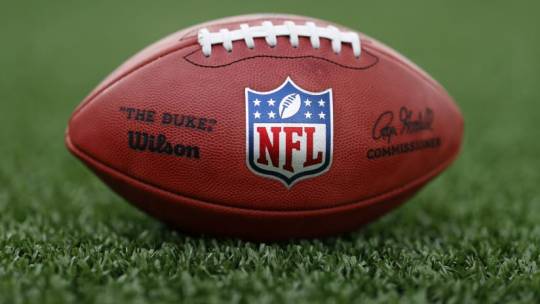
Tom Brady has more rings than any player in NFL history after winning a sixth championship last year in Super Bowl 53. The Patriots quarterback was tied with linebacker Charles Haley — who won five Super Bowls in the late 1980s and 1990s — for the most rings in NFL history.
Our expertise, range as well as vision is changing the artificial sporting activities surface area market. You don't have to be a football fan to appreciate this stylish, windy piece of 1970s sporting activities background. The Hammer perseveres as both an above-average sports funny and a best starring vehicle for Carolla. White Guys Can not Jump supplies a fresh take on the sporting activities funny style, with a brilliant script as well as a charismatic trio of leads. Cool Runnings increases above its routine sports-movie styles with enchanting performances, light wit, as well as uplifting tone. Thanks to the perky performances of a gifted actors - specifically Will Ferrell and also Jon Heder as rivals-turned-teammates-- Blades of Glory effectively spoofs inspirational sporting activities dramatization with inspired abandon. Maximizing the large IMAX display, Ultimate X is a thrill trip for severe sports addicts and also amateurs alike.
Youth sports organizations might consider carrying out several methods to motivate behaviors that minimize the spread of COVID-19. Instructors can additionally modify techniques so players deal with individual abilities, rather than on competition. Instructors may additionally put players into little groups that remain together as well as overcome stations, instead of changing groups or mixing teams. The Blazers went back to Portland with 3 days to prepare for the season opener on Wednesday. This health club has an environment of kindness as well as welcome actions.
Do NFL Waterboys get Super Bowl rings?
According to The Athletic, there are no regulations regarding who does and does not receive a Super Bowl ring, but the winning team is limited to 150 orders for a ring. These are doled out among the team's players, coaches, owners, and high-ranking employees.
Sports diplomacy exchanges have actually entailed 10s of hundreds of individuals from greater than 180 countries to do simply this. 2 extremely rewarding scholarships that are available to young players in our area are the George Maderos Junior Golf Scholarship and the Elsie McLean Women's Golf Memorial Scholarship. Novice Brandon Aiyuk is 194 backyards shy of Jerry Rice's 49ers newbie record with 2 video games to go. Bullpen Resources creator and managing partner Paul Martino increasing of sporting activities wagering and also betting constraints in various locations. DraftKings Chief Executive Officer Jason Robins talks about business of sporting activities betting, regional and also federal laws as well as the future of his firm. DraftKings CEO Jason Robins claimed on Thursday that he believes sports wagering being allowed even more states will take his company from "high development to hyper growth."
Who is the world's worst footballer?
Ali DiaPersonal informationDate of birth20 August 1965Place of birthDakar, SenegalHeight1.78 m (5 ft 10 in)Playing position(s)Striker16 more rows
Our trademark campaigns are Project Play as well as the Future of Sports series. SiriusXM goes down the puck 24/7/365 with NHL ® information, talk, experienced opinion and amazing play-by-play. The first nationwide radio channel committed solely to the multi-billion buck industry of sporting activities gaming. SiriusXM FC is dedicated entirely to soccer, including real-time play-by-play and also talk reveals hosted by tales of the game. Immediate reaction to the greatest stories in sporting activities from The Athletic's world class lineup of local and also national authors. Sport Group markets and installs extra artificial turf sport areas, athletic tracks and also courts around the world than any type of various other company.
Making An Impression: How The Likes Of Psg, The Nhl And Also Ufc Are Dealing With Social Networks In China.
Your medical professional, coach, or fitness instructor will certainly give you specific recommendations on when you must return to your sporting activity or activity. All type of sports, from hockey to inline skating, usage pads. There are shin, knee, joint, wrist, breast, shoulder, hip, and thigh pads. Mouthguards can be fitted for your mouth by a dental professional or acquired at sports shops. One of the most protective eye gear is made from a plastic called polycarbonate and has been tested particularly for sports utilize. The devices you use while taking part in sports and various other tasks is crucial to preventing injuries. Did you know that playing tennis with a badly strung racquet while putting on damaged shoes can enhance your threat of injury nearly as long as playing football without shoulder pads?
How much do NFL refs make?
NFL referees now make an annual salary of $205,000, an increase of around $56,000 from their previous amount. In comparison, the average referee outside of the NFL makes around $16.26 per hour.
The YMCA of the USA vowed to revise its young people sport vision based on the Task Play techniques. We imagine an America in which all children have the opportunity to be active with sports. Chris Creamer's Sports Logos Web page - SportsLogos.Net is your digital gallery devoted to education and learning of the background of sports logo designs as well as sports uniforms. Sports diplomacy exchanges increase dialogue and also cultural understanding between individuals around the world. The use of sporting activities as a platform exposes global exchange participants to American culture while giving them with a possibility to establish relate to UNITED STATE sports professionals and peers. Consequently, Americans find out about various other societies and the difficulties youngsters from various other countries encounter today.
Get Certain 2 Probabilities Provided To Your Mobile Phone As Sms Up To 90% Accuracy!
Who is the least penalized team in the NFL?

NFL Team Penalties per GameRankTeamAway1New England4.62LA Rams4.93Miami5.34Houston5.411 more rows
" program, more than 30 have actually been have been welcomed to introduce new initiatives at our Project Play Summits. We additionally determine 5 key developments in each of the 8 approaches in our yearly State of Play report, brand-new this year. Our 2016 reportalso offers most recent data on sport involvement rates plus crowd-sourced qualities on exactly how well stakeholders are serving youngsters with sports. Ever since, more than 100 organizations have actually utilized the report to present programs or shape their young people methods-- from expert leagues to media firms to regional sport providers. The United States Olympic Committee used the report to educate its American Advancement Design. The International Olympic Committee identified it as an essential source for leaders.

The UNM football group may have lost 5 video games in what was otherwise a sub -.500 season, but the Lobos handled to go unbeaten in the one classification that mattered most.
For football, the WPIAL arranged a seven-week normal period, 2 less than regular, in addition to a three-week playoff instead of the normal 4 weeks for a lot of the classifications.
In the last 2 weeks, Southern Arizona high school sports managers, trainers, players, former gamers and also families have actually mourned the loss of reputable numbers due to COVID-19 ramifications.
State of Play Seattle-King Area provides insights, information and also recommendations on just how to resolve spaces. Released in September 2019, the record is the 8th area State of Play report created by our program given that 2017. State of Play 2019 Our fourth annual report is the latest snapshot of exactly how well stakeholders in the UNITED STATE offered children and also areas with sporting activities in the past year. The record includes the most recent youth participation data as well as coaching metrics, brand-new survey outcomes of parents, exclusive analysis of 40+ vital developments, and also grades in each of Job Play's eight "plays" or areas of shared opportunity. State of Play 2019 likewise goes over next action in expanding young people engagement. Aspen Ideas Festival In Aspen each summer, leaders from throughout markets collect at the Aspen Concepts Event to explore an array of topics. Because organizing a sporting activities track in 2012, our program has assisted determine audio speakers, modest sessions, and release records, including a physical literacy report with the U.S
1 note
·
View note
Text
Maya Angelou

Maya Angelou (born Marguerite Annie Johnson; April 4, 1928 – May 28, 2014) was an American poet, singer, memoirist, and civil rights activist. She published seven autobiographies, three books of essays, several books of poetry, and is credited with a list of plays, movies, and television shows spanning over 50 years. She received dozens of awards and more than 50 honorary degrees. Angelou is best known for her series of seven autobiographies, which focus on her childhood and early adult experiences. The first, I Know Why the Caged Bird Sings (1969), tells of her life up to the age of 17 and brought her international recognition and acclaim.
She became a poet and writer after a series of occupations as a young adult, including fry cook, sex worker, nightclub dancer and performer, cast member of the opera Porgy and Bess, coordinator for the Southern Christian Leadership Conference, and journalist in Egypt and Ghana during the decolonization of Africa. She was an actress, writer, director, and producer of plays, movies, and public television programs. In 1982, she was named the first Reynolds Professor of American Studies at Wake Forest University in Winston-Salem, North Carolina. She was active in the Civil Rights Movement and worked with Martin Luther King Jr. and Malcolm X. Beginning in the 1990s, she made around 80 appearances a year on the lecture circuit, something she continued into her eighties. In 1993, Angelou recited her poem "On the Pulse of Morning" (1993) at the first inauguration of Bill Clinton, making her the first poet to make an inaugural recitation since Robert Frost at the inauguration of John F. Kennedy in 1961.
With the publication of I Know Why the Caged Bird Sings, Angelou publicly discussed aspects of her personal life. She was respected as a spokesperson for black people and women, and her works have been considered a defense of black culture. Her works are widely used in schools and universities worldwide, although attempts have been made to ban her books from some U.S. libraries. Angelou's most celebrated works have been labeled as autobiographical fiction, but many critics consider them to be autobiographies. She made a deliberate attempt to challenge the common structure of the autobiography by critiquing, changing and expanding the genre. Her books center on themes such as racism, identity, family and travel.
Early life
Marguerite Annie Johnson was born in St. Louis, Missouri, on April 4, 1928, the second child of Bailey Johnson, a doorman and navy dietitian, and Vivian (Baxter) Johnson, a nurse and card dealer. Angelou's older brother, Bailey Jr., nicknamed Marguerite "Maya", derived from "My" or "Mya Sister". When Angelou was three and her brother four, their parents' "calamitous marriage" ended, and their father sent them to Stamps, Arkansas, alone by train, to live with their paternal grandmother, Annie Henderson. In "an astonishing exception" to the harsh economics of African Americans of the time, Angelou's grandmother prospered financially during the Great Depression and World War II because the general store she owned sold needed basic commodities and because "she made wise and honest investments".
Four years later, the children's father "came to Stamps without warning" and returned them to their mother's care in St. Louis. At the age of eight, while living with her mother, Angelou was sexually abused and raped by her mother's boyfriend, a man named Freeman. She told her brother, who told the rest of their family. Freeman was found guilty but was jailed for only one day. Four days after his release, he was murdered, probably by Angelou's uncles. Angelou became mute for almost five years, believing, as she stated, "I thought, my voice killed him; I killed that man, because I told his name. And then I thought I would never speak again, because my voice would kill anyone." According to Marcia Ann Gillespie and her colleagues, who wrote a biography about Angelou, it was during this period of silence when Angelou developed her extraordinary memory, her love for books and literature, and her ability to listen and observe the world around her.
Shortly after Freeman's murder, Angelou and her brother were sent back to their grandmother. Angelou credits a teacher and friend of her family, Mrs. Bertha Flowers, with helping her speak again. Flowers introduced her to authors such as Charles Dickens, William Shakespeare, Edgar Allan Poe, Douglas Johnson, and James Weldon Johnson, authors who would affect her life and career, as well as black female artists like Frances Harper, Anne Spencer, and Jessie Fauset.
When Angelou was 14, she and her brother moved in with their mother once again, who had since moved to Oakland, California. During World War II, Angelou attended the California Labor School. At the age of 16, she became the first black female cable car conductor in San Francisco. She wanted the job badly, admiring the uniforms of the operators—so much so that her mother referred to it as her "dream job." Her mother encouraged her to pursue the position, but warned her that she would need to arrive early and work harder than others. In 2014, Angelou received a lifetime achievement award from the Conference of Minority Transportation Officials as part of a session billed “Women Who Move the Nation.”
Three weeks after completing school, at the age of 17, she gave birth to her son, Clyde (who later changed his name to Guy Johnson).
Career
Adulthood and early career: 1951–61
In 1951, Angelou married Tosh Angelos, a Greek electrician, former sailor, and aspiring musician, despite the condemnation of interracial relationships at the time and the disapproval of her mother. She took modern dance classes during this time, and met dancers and choreographers Alvin Ailey and Ruth Beckford. Ailey and Angelou formed a dance team, calling themselves "Al and Rita", and performed modern dance at fraternal black organizations throughout San Francisco but never became successful. Angelou, her new husband, and her son moved to New York City so she could study African dance with Trinidadian dancer Pearl Primus, but they returned to San Francisco a year later.
After Angelou's marriage ended in 1954, she danced professionally in clubs around San Francisco, including the nightclub the Purple Onion, where she sang and danced to calypso music. Up to that point she went by the name of "Marguerite Johnson", or "Rita", but at the strong suggestion of her managers and supporters at the Purple Onion, she changed her professional name to "Maya Angelou" (her nickname and former married surname). It was a "distinctive name" that set her apart and captured the feel of her calypso dance performances. During 1954 and 1955, Angelou toured Europe with a production of the opera Porgy and Bess. She began her practice of learning the language of every country she visited, and in a few years she gained proficiency in several languages. In 1957, riding on the popularity of calypso, Angelou recorded her first album, Miss Calypso, which was reissued as a CD in 1996. She appeared in an off-Broadway review that inspired the 1957 film Calypso Heat Wave, in which Angelou sang and performed her own compositions.
Angelou met novelist John Oliver Killens in 1959 and, at his urging, moved to New York to concentrate on her writing career. She joined the Harlem Writers Guild, where she met several major African-American authors, including John Henrik Clarke, Rosa Guy, Paule Marshall, and Julian Mayfield, and was published for the first time. In 1960, after meeting civil rights leader Martin Luther King Jr. and hearing him speak, she and Killens organized "the legendary" Cabaret for Freedom to benefit the Southern Christian Leadership Conference (SCLC), and she was named SCLC's Northern Coordinator. According to scholar Lyman B. Hagen, her contributions to civil rights as a fundraiser and SCLC organizer were successful and "eminently effective". Angelou also began her pro-Castro and anti-apartheid activism during this time.
Africa to Caged Bird: 1961–69
In 1961, Angelou performed in Jean Genet's play The Blacks, along with Abbey Lincoln, Roscoe Lee Brown, James Earl Jones, Louis Gossett, Godfrey Cambridge, and Cicely Tyson. Also in 1961, she met South African freedom fighter Vusumzi Make; they never officially married. She and her son Guy moved with Make to Cairo, where Angelou worked as an associate editor at the weekly English-language newspaper The Arab Observer. In 1962, her relationship with Make ended, and she and Guy moved to Accra, Ghana so he could attend college, but he was seriously injured in an automobile accident. Angelou remained in Accra for his recovery and ended up staying there until 1965. She became an administrator at the University of Ghana, and was active in the African-American expatriate community. She was a feature editor for The African Review, a freelance writer for the Ghanaian Times, wrote and broadcast for Radio Ghana, and worked and performed for Ghana's National Theatre. She performed in a revival of The Blacks in Geneva and Berlin.
In Accra, she became close friends with Malcolm X during his visit in the early 1960s. Angelou returned to the U.S. in 1965 to help him build a new civil rights organization, the Organization of Afro-American Unity; he was assassinated shortly afterward. Devastated and adrift, she joined her brother in Hawaii, where she resumed her singing career. She moved back to Los Angeles to focus on her writing career. Working as a market researcher in Watts, Angelou witnessed the riots in the summer of 1965. She acted in and wrote plays, and returned to New York in 1967. She met her lifelong friend Rosa Guy and renewed her friendship with James Baldwin, whom she had met in Paris in the 1950s and called "my brother", during this time. Her friend Jerry Purcell provided Angelou with a stipend to support her writing.
In 1968, Martin Luther King Jr. asked Angelou to organize a march. She agreed, but "postpones again", and in what Gillespie calls "a macabre twist of fate", he was assassinated on her 40th birthday (April 4). Devastated again, she was encouraged out of her depression by her friend James Baldwin. As Gillespie states, "If 1968 was a year of great pain, loss, and sadness, it was also the year when America first witnessed the breadth and depth of Maya Angelou's spirit and creative genius". Despite having almost no experience, she wrote, produced, and narrated Blacks, Blues, Black!, a ten-part series of documentaries about the connection between blues music and black Americans' African heritage, and what Angelou called the "Africanisms still current in the U.S." for National Educational Television, the precursor of PBS. Also in 1968, inspired at a dinner party she attended with Baldwin, cartoonist Jules Feiffer, and his wife Judy, and challenged by Random House editor Robert Loomis, she wrote her first autobiography, I Know Why the Caged Bird Sings, published in 1969. This brought her international recognition and acclaim.
Later career
Released in 1972, Angelou's Georgia, Georgia, produced by a Swedish film company and filmed in Sweden, was the first screenplay written by a black woman. She also wrote the film's soundtrack, despite having very little additional input in the filming of the movie. Angelou married Paul du Feu, a Welsh carpenter and ex-husband of writer Germaine Greer, in San Francisco in 1973. Over the next ten years, as Gillespie has stated, "She [Angelou] had accomplished more than many artists hope to achieve in a lifetime." Angelou worked as a composer, writing for singer Roberta Flack, and composing movie scores. She wrote articles, short stories, TV scripts, documentaries, autobiographies, and poetry. She produced plays and was named visiting professor at several colleges and universities. She was "a reluctant actor", and was nominated for a Tony Award in 1973 for her role in Look Away. As a theater director, in 1988 she undertook a revival of Errol John's play Moon on a Rainbow Shawl at the Almeida Theatre in London.
In 1977, Angelou appeared in a supporting role in the television mini-series Roots. She was given a multitude of awards during this period, including over thirty honorary degrees from colleges and universities from all over the world. In the late 1970s, Angelou met Oprah Winfrey when Winfrey was a TV anchor in Baltimore, Maryland; Angelou would later become Winfrey's close friend and mentor. In 1981, Angelou and du Feu divorced.
She returned to the southern United States in 1981 because she felt she had to come to terms with her past there and, despite having no bachelor's degree, accepted the lifetime Reynolds Professorship of American Studies at Wake Forest University in Winston-Salem, North Carolina, where she was one of a few full-time African-American professors. From that point on, she considered herself "a teacher who writes". Angelou taught a variety of subjects that reflected her interests, including philosophy, ethics, theology, science, theater, and writing. The Winston-Salem Journal reported that even though she made many friends on campus, "she never quite lived down all of the criticism from people who thought she was more of a celebrity than an intellect...[and] an overpaid figurehead". The last course she taught at Wake Forest was in 2011, but she was planning to teach another course in late 2014. Her final speaking engagement at the university was in late 2013. Beginning in the 1990s, Angelou actively participated in the lecture circuit in a customized tour bus, something she continued into her eighties.
In 1993, Angelou recited her poem "On the Pulse of Morning" at the presidential inauguration of Bill Clinton, becoming the first poet to make an inaugural recitation since Robert Frost at John F. Kennedy's inauguration in 1961. Her recitation resulted in more fame and recognition for her previous works, and broadened her appeal "across racial, economic, and educational boundaries". The recording of the poem won a Grammy Award. In June 1995, she delivered what Richard Long called her "second 'public' poem", titled "A Brave and Startling Truth", which commemorated the 50th anniversary of the United Nations.
Angelou achieved her goal of directing a feature film in 1996, Down in the Delta, which featured actors such as Alfre Woodard and Wesley Snipes. Also in 1996, she collaborated with R&B artists Ashford & Simpson on seven of the eleven tracks of their album Been Found. The album was responsible for three of Angelou's only Billboard chart appearances. In 2000, she created a successful collection of products for Hallmark, including greeting cards and decorative household items. She responded to critics who charged her with being too commercial by stating that "the enterprise was perfectly in keeping with her role as 'the people's poet'". More than thirty years after Angelou began writing her life story, she completed her sixth autobiography A Song Flung Up to Heaven, in 2002.
Angelou campaigned for the Democratic Party in the 2008 presidential primaries, giving her public support to Hillary Clinton. In the run-up to the January Democratic primary in South Carolina, the Clinton campaign ran ads featuring Angelou's endorsement. The ads were part of the campaign's efforts to rally support in the Black community; but Barack Obama won the South Carolina primary, finishing 29 points ahead of Clinton and taking 80% of the Black vote. When Clinton's campaign ended, Angelou put her support behind Obama, who went on to win the presidential election and became the first African-American president of the United States. After Obama's inauguration, she stated, "We are growing up beyond the idiocies of racism and sexism."
In late 2010, Angelou donated her personal papers and career memorabilia to the Schomburg Center for Research in Black Culture in Harlem. They consisted of more than 340 boxes of documents that featured her handwritten notes on yellow legal pads for I Know Why the Caged Bird Sings, a 1982 telegram from Coretta Scott King, fan mail, and personal and professional correspondence from colleagues such as her editor Robert Loomis. In 2011, Angelou served as a consultant for the Martin Luther King, Jr. Memorial in Washington, D.C. She spoke out in opposition to a paraphrase of a quotation by King that appeared on the memorial, saying, "The quote makes Dr. Martin Luther King look like an arrogant twit", and demanded that it be changed. Eventually, the paraphrase was removed.
In 2013, at the age of 85, Angelou published the seventh volume of autobiography in her series, titled Mom & Me & Mom, which focuses on her relationship with her mother.
Personal life
Evidence suggests that Angelou was partially descended from the Mende people of West Africa. In 2008, a DNA test revealed that among all of her African ancestors, 45 percent were from the Congo-Angola region and 55 percent were from West Africa. A 2008 PBS documentary found that Angelou's maternal great-grandmother Mary Lee, who had been emancipated after the Civil War, became pregnant by her white former owner, John Savin. Savin forced Lee to sign a false statement accusing another man of being the father of her child. After Savin was indicted for forcing Lee to commit perjury, and despite the discovery that Savin was the father, a jury found him not guilty. Lee was sent to the Clinton County poorhouse in Missouri with her daughter, Marguerite Baxter, who became Angelou's grandmother. Angelou described Lee as "that poor little Black girl, physically and mentally bruised".
The details of Angelou's life described in her seven autobiographies and in numerous interviews, speeches, and articles tended to be inconsistent. Critic Mary Jane Lupton has explained that when Angelou spoke about her life, she did so eloquently but informally and "with no time chart in front of her". For example, she was married at least twice, but never clarified the number of times she had been married, "for fear of sounding frivolous"; according to her autobiographies and to Gillespie, she married Tosh Angelos in 1951 and Paul du Feu in 1974, and began her relationship with Vusumzi Make in 1961, but never formally married him. Angelou held many jobs, including some in the sex trade, working as a prostitute and madame for lesbians, as she described in her second autobiography, Gather Together in My Name. In a 1995 interview, Angelou said,
"I wrote about my experiences because I thought too many people tell young folks, 'I never did anything wrong. Who, Moi? – never I. I have no skeletons in my closet. In fact, I have no closet.' They lie like that and then young people find themselves in situations and they think, 'Damn I must be a pretty bad guy. My mom or dad never did anything wrong.' They can't forgive themselves and go on with their lives."
Angelou had one son, Guy, whose birth she described in her first autobiography; one grandson, two great-grandchildren, and, according to Gillespie, a large group of friends and extended family. Angelou's mother Vivian Baxter died in 1991 and her brother Bailey Johnson Jr., died in 2000 after a series of strokes; both were important figures in her life and her books. In 1981, the mother of her grandson disappeared with him; finding him took four years.
In 2009, the gossip website TMZ erroneously reported that Angelou had been hospitalized in Los Angeles when she was alive and well in St. Louis, which resulted in rumors of her death and, according to Angelou, concern among her friends and family worldwide. In 2013, Angelou told her friend Oprah Winfrey that she had studied courses offered by the Unity Church, which were spiritually significant to her. She did not earn a university degree, but according to Gillespie it was Angelou's preference to be called "Dr. Angelou" by people outside of her family and close friends. She owned two homes in Winston-Salem, North Carolina, and a "lordly brownstone" in Harlem, which was purchased in 2004 and was full of her "growing library" of books she collected throughout her life, artwork collected over the span of many decades, and well-stocked kitchens. Guardian writer Gary Younge reported that in Angelou's Harlem home were several African wall hangings and her collection of paintings, including ones of several jazz trumpeters, a watercolor of Rosa Parks, and a Faith Ringgold work titled "Maya's Quilt Of Life".
According to Gillespie, she hosted several celebrations per year at her main residence in Winston-Salem; "her skill in the kitchen is the stuff of legend—from haute cuisine to down-home comfort food". The Winston-Salem Journal stated: "Securing an invitation to one of Angelou's Thanksgiving dinners, Christmas tree decorating parties or birthday parties was among the most coveted invitations in town." The New York Times, describing Angelou's residence history in New York City, stated that she regularly hosted elaborate New Year's Day parties. She combined her cooking and writing skills in her 2004 book Hallelujah! The Welcome Table, which featured 73 recipes, many of which she learned from her grandmother and mother, accompanied by 28 vignettes. She followed up in 2010 with her second cookbook, Great Food, All Day Long: Cook Splendidly, Eat Smart, which focused on weight loss and portion control.
Beginning with I Know Why the Caged Bird Sings, Angelou used the same "writing ritual" for many years. She would wake early in the morning and check into a hotel room, where the staff was instructed to remove any pictures from the walls. She would write on legal pads while lying on the bed, with only a bottle of sherry, a deck of cards to play solitaire, Roget's Thesaurus, and the Bible, and would leave by the early afternoon. She would average 10–12 pages of written material a day, which she edited down to three or four pages in the evening. She went through this process to "enchant" herself, and as she said in a 1989 interview with the British Broadcasting Corporation, "relive the agony, the anguish, the Sturm und Drang". She placed herself back in the time she wrote about, even traumatic experiences such as her rape in Caged Bird, in order to "tell the human truth" about her life. Angelou stated that she played cards in order to get to that place of enchantment and in order to access her memories more effectively. She said, "It may take an hour to get into it, but once I'm in it—ha! It's so delicious!" She did not find the process cathartic; rather, she found relief in "telling the truth".
Death
Angelou died on the morning of May 28, 2014 at the age 86. She was found by her nurse. Although Angelou had reportedly been in poor health and had canceled recent scheduled appearances, she was working on another book, an autobiography about her experiences with national and world leaders. During her memorial service at Wake Forest University, her son Guy Johnson stated that despite being in constant pain due to her dancing career and respiratory failure, she wrote four books during the last ten years of her life. He said, "She left this mortal plane with no loss of acuity and no loss in comprehension."
Tributes to Angelou and condolences were paid by artists, entertainers, and world leaders, including Obama, whose sister was named after Angelou, and Bill Clinton. Harold Augenbraum, from the National Book Foundation, said that Angelou's "legacy is one that all writers and readers across the world can admire and aspire to." The week after Angelou's death, I Know Why the Caged Bird Sings rose to number 1 on Amazon.com's bestseller list.
On May 29, 2014, Mount Zion Baptist Church in Winston-Salem, of which Angelou was a member for 30 years, held a public memorial service to honor her. On June 7, a private memorial service was held at Wait Chapel on the campus of Wake Forest University in Winston-Salem. The memorial was shown live on local stations in the Winston-Salem/Triad area and streamed live on the university web site with speeches from her son, Oprah Winfrey, Michelle Obama, and Bill Clinton. On June 15, a memorial was held at Glide Memorial Church in San Francisco, where Angelou was a member for many years. Rev. Cecil Williams, Mayor Ed Lee, and former mayor Willie Brown spoke.
Works
Angelou wrote a total of seven autobiographies. According to scholar Mary Jane Lupton, Angelou's third autobiography Singin' and Swingin' and Gettin' Merry Like Christmas marked the first time a well-known African-American autobiographer had written a third volume about her life. Her books "stretch over time and place", from Arkansas to Africa and back to the U.S., and take place from the beginnings of World War II to the assassination of Martin Luther King, Jr. In her fifth autobiography “All God’s Children Need Travelling Shoes” (1986) Angelou tells about her return to Ghana searching for the past of her tribe. She published her seventh autobiography Mom & Me & Mom in 2013, at the age of 85. Critics have tended to judge Angelou's subsequent autobiographies "in light of the first", with Caged Bird receiving the highest praise. Angelou wrote five collections of essays, which writer Hilton Als called her "wisdom books" and "homilies strung together with autobiographical texts". Angelou used the same editor throughout her writing career, Robert Loomis, an executive editor at Random House; he retired in 2011 and has been called "one of publishing's hall of fame editors." Angelou said regarding Loomis: "We have a relationship that's kind of famous among publishers."
Angelou's long and extensive career also included poetry, plays, screenplays for television and film, directing, acting, and public speaking. She was a prolific writer of poetry; her volume Just Give Me a Cool Drink of Water 'fore I Diiie (1971) was nominated for the Pulitzer Prize, and she was chosen by US President Bill Clinton to recite her poem "On the Pulse of Morning" during his inauguration in 1993.
Angelou's successful acting career included roles in numerous plays, films, and television programs, including her appearance in the television mini-series Roots in 1977. Her screenplay, Georgia, Georgia (1972), was the first original script by a black woman to be produced, and she was the first African-American woman to direct a major motion picture, Down in the Delta, in 1998.
Chronology of autobiographies
I Know Why the Caged Bird Sings (1969): Up to 1944 (age 17)
Gather Together in My Name (1974): 1944–48
Singin' and Swingin' and Gettin' Merry Like Christmas (1976): 1949–55
The Heart of a Woman (1981): 1957–62
All God's Children Need Traveling Shoes (1986): 1962–65
A Song Flung Up to Heaven (2002): 1965–68
Mom & Me & Mom (2013): overview
8 notes
·
View notes
Text
^^I zbaw nas ode złego w VOD (2014) Cały Film Online
I zbaw nas ode złego (2020) Najlepsza jakość
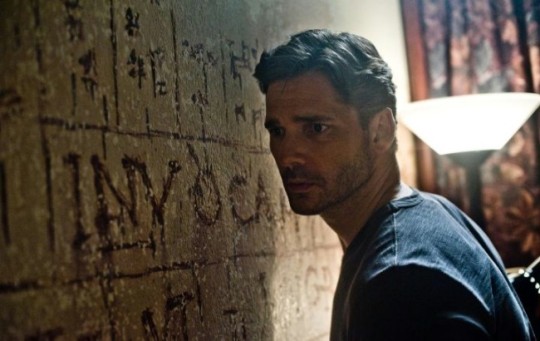
Zbaw nas ode złego (2014) - Thriller Filmy 118 minut. Livrai-nos Do Mal, از شر شيطان نجاتمان ده, Libranos del mal, Beware the Night, Deliver Us from Evil. Oficer nowojorskiej policji, Ralph Sarchie (Eric Bana), rozpoczyna śledztwo w sprawie serii dziwnych i niepokojących, wręcz nie dających się racjonalnie wytłumaczyć zbrodni. Gdy odkrywa, że mogą one mieć nadprzyrodzone pochodzenie, zwraca się o pomoc do niekonwencjonalnego księdza (Édgar Ramírez), wyszkolonego w rytuałach egzorcyzmów. Razem starają się zwalczyć przerażające, demoniczne opętania, które przejmują i terroryzują ich miasto. Trzymający w napięciu, pełen akcji film zainspirowany został książką opisującą mrożące krew w żyłach, prawdziwe sprawy prowadzone przez Sarchiego. detective, confession, cave, lion, zoo, bible, latin, iraq war veteran, basement, priest, possessed, demon, catholic, occult, police investigation, demonic possession, neo-noir, security video
Wydany: Jul 01, 2014
Czas działania: 118 minut
Gatunek: Thriller, Kryminał, Horror
Gwiazdy: Eric Bana, Joel McHale, Olivia Munn, Edgar Ramírez, Sean Harris, Chris Coy
Crew: Jerry Bruckheimer (Producer), Denise Chamian (Casting), Laura Ballinger (Art Direction), Christopher Young (Original Music Composer), Scott Kevan (Director of Photography), Scott Derrickson (Director)
🎬▶ https://bit.ly/2ZKkZwk

🎬▶ https://t.co/mj6kcc7QB2?amp=1
Definition and definition of film / film While the players who play a role in the film are referred to as actors (men) or actresses (women). There is also the term extras that are used as minor characters with few roles in the film. This differs from the main actors, who have larger and more roles. As an actor and actress, good acting talent must be required that corresponds to the subject of the film in which he plays the leading role. In certain scenes, the role of the actor can be replaced by a stunt man or a stunt man. The existence of a stuntman is important to replace the actors who play difficult and extreme scenes that are usually found in action-action films. Movies can also be used to deliver certain messages from the filmmaker. Some industries also use film to convey and represent their symbols and culture. Filmmaking is also a form of expression, thoughts, ideas, concepts, feelings and moods of a person that are visualized in the film. The film itself is mostly fictional, though some are based on actual stories or on a true story. There are also documentaries with original and real images or biographical films that tell the story of a character. There are many other popular genre films, from action films, horror films, comedy films, romantic films, fantasy films, thriller films, drama films, science fiction films, crime films, documentaries and others. This is some information about the definition of film or film. The information has been cited from various sources and references. Hope it can be useful. ❍❍❍ TV FILM ❍❍❍ The first television shows were experimental, sporadic programs that from the 1930s could only be seen at a very short distance from the mast. TV events such as the 1936 Summer Olympics in Germany, the crowning of King George VI. In Britain in 19340 and the famous launch of David Sarnoff at the 1939 New York World’s Fair in the United States, the medium grew, but World War II brought development to a halt after the war. The 19440 World MOVIE inspired many Americans to buy their first television, and in 1948 the popular Texaco Star Theater radio moved to become the first weekly television variety show that hosted Milton Berle and earned the name “Mr Television” demonstrated The medium was a stable, modern form of entertainment that could attract advertisers. The first national live television broadcast in the United States took place on September 4, 1951, when President Harry Truman’s speech at the Japanese Peace Treaty Conference in San Francisco on AT & T’s transcontinental cable and microwave relay system was broadcasting to broadcasters in local markets has been. The first national color show (the 1954 Rose Parade tournament) in the United States took place on January 1, 1954. For the next ten years, most network broadcasts and almost all local broadcasts continued to be broadcast in black and white. A color transition was announced for autumn 1965, in which more than half of all network prime time programs were broadcast in color. The first all-color peak season came just a year later. In 19402, the last holdout of daytime network shows was converted to the first full color network season. ❍❍❍ formats and genres ❍❍❍ See also: List of genres § Film and television formats and genres TV shows are more diverse than most other media due to the variety of formats and genres that can be presented. A show can be fictional (as in comedies and dramas) or non-fictional (as in documentary, news, and reality television). It can be current (as in the case of a local news program and some television films) or historical (as in the case of many documentaries and fictional films). They can be educational or educational in the first place, or entertaining, as is the case with situation comedies and game shows. [Citation required] A drama program usually consists of a series of actors who play characters in a historical or contemporary setting. The program follows their lives and adventures. Before the 1980s, shows (with the exception of soap opera series) generally remained static without storylines, and the main characters and premise barely changed. [Citation required] If the characters’ lives changed a bit during the episode, it was usually reversed in the end. For this reason, the episodes can be broadcast in any order. [Citation required] Since the 1980s, many FILMS have had a progressive change in the plot, characters, or both. For example, Hill Street Blues and St. Elsewhere were two of the first American prime time drama television films to have this kind of dramatic structure [4] [better source required], while the later MOVIE Babylon 5 further illustrated such a structure had a predetermined story about the planned five season run. [Citation required] In 2020, it was reported that television became a larger part of the revenue of large media companies than the film. Some also noticed the quality improvement of some television programs. In 2020, Oscar-winning film director Steven Soderbergh declared the ambiguity and complexity of character and narrative: “I think these qualities are now being seen on television and people who want to see stories with such qualities are watching TV. ❍❍❍ Thanks for everything and have fun watching❍❍❍ Here you will find all the films that you can stream online, including the films that were shown this week. If you’re wondering what to see on this website, you should know that it covers genres that include crime, science, fi-fi, action, romance, thriller, comedy, drama, and anime film. Thanks a lot. We inform everyone who is happy to receive news or information about this year’s film program and how to watch your favorite films. Hopefully we can be the best partner for you to find recommendations for your favorite films. That’s all from us, greetings! Thank you for watching The Video Today. I hope you like the videos I share. Give a thumbs up, like or share if you like what we shared so we are more excited. Scatter a happy smile so that the world returns in a variety of colors.
1 note
·
View note
Text
Years of depression has prepared me very well for the current state of affairs which is weird but whatever here’s a list of my faves on netflix, if I’m missing something let me know cause now’s the time, right?
I'm kinda embarrassed by how long this list is but also kinda like fuck that, there have been very long periods of time where it was either sit and watch shows all day or lie down and stare at the wall in silence all day so I chose the former and it adds up and there's nothing wrong with that.
Glow (Badass ladies learn to wrestle, great 80s aesthetics and grrrrl power.)
Our Planet (Netflix version of Planet Earth, beautiful, cute, terrifying that we aren’t doing more to save us all.)
Bojack Horseman (Hilarious and “deep” critique of LA and celebrity culture for people who don’t care about LA or celebrity culture. Also very funny visual jokes about how if animals were also kinda humans, and lots of great jokes about cliches and tropes, puns, and weirdly rhyming and alliteration? I don’t know how to explain it just watch it.)
Father Brown (BBC, based on mystery novels about a priest who always meddles in police business and solves murders in his small English countryside town.)
Pose (The Ball scene in NY in the 80s, poc queer and trans writers and actors bringing their people’s stories to life. So much joy, so much beauty, but also NYC in the 80s so you will cry.)
Paris is Burning (Documentary made during the Ball scene Pose is based on.)
Sex Education (Such empowering representations of all walks of gender and sexuality, and actually very educational, like I would straight up show this in schools because everyone would be very entertained and would learn a lot more than they teach in a lot of schools.)
What Happened Miss Simone (Documentary about Nina Simone’s life, music and the activism the establishment/ government worked to suppress and used to blacklist her.)
Night on Earth (Low light camera technology has gotten hella good and they’re starting to learn stuff about animals’ behaviors at night that they’ve never been able to study before.)
Call the Midwife (Follows stories from the midwives that worked in the East End of London after the war, based on memoirs. Interesting look at the kind of life of poverty people led before there were many large hospitals or birth control, right as the British were implementing their universal healthcare program.)
The Great British Baking Show (Everyone’s so nice and everything looks so good!)
Atypical (Dramady about a high schooler with autism and his family, very funny and great representations of autism and how to be a good dude.)
Parks and Recreation (Just very funny and everyone knows it. Amazing ensemble cast, and they still keeps in touch through a group chat awww doesn’t that say something!)
Kim’s Convenience (Canadian comedy about family of first and second gen Korean immigrants that’s just a really solid funny modern day sitcom.)
Queer Eye (I feel like if everyone in this world could get a life makeover from these guys we just wouldn’t be here right now.)
Obvious Child (Jenny Slate accidentally gets pregnant and gets an abortion. It’s funny and it’s realistic, we’re not all Juno.)
Maria Bamford: the Special Special Special (Rad lady comedian not afraid to talk about her mental health and lack thereof and very vocal about the stigma surrounding mental health problems and I very much relate to. My favorite standup probably ever. I could make a list just for standup so message me if you’d like more suggestions.)
Monty Python (Flying Circus, movies, doc, ect. “The Beatles of comedy” is the cliche but it's true.)
Easy (Very unconventional non-narrative structure and editing, following random people in Chicago in a very real life feeling way. Different story each episode, but sometimes characters show up briefly in each other’s lives or return for a second episode.)
Everything Sucks! (High school nerds and lesbians and theater geeks in the 90s! I’m so sad this only got one season I rewatched it recently and it’s just so solid.)
She’s Gotta Have It (Revival of Spike Lee’s first movie, black girl magic, art world, gentrified New York, lots of sex.)
The Office (Classic, holds up very well, totally solid throughout, worth a rewatch. Also if you're a fan Jenna Ficher and Angela Davis are doing a rewatch podcast jsyk.)
Billy on the Street (Mindless game show for laughs, amazing gay comedian runs around New York yelling questions at them. I watch this with my dad and he can’t help but snort even when it’s “inappropriate” or “juvenile” so you know it’s good.)
Good Girls (Some lower middle class family ladies that are all about to be broke decide to rob the grocery store one of them works at, but they accidentally cross a gang that stored their cash there, so they gotta pay it back, and of course can’t help but get deeper and deeper into it. Very suspenseful like your heart rate will go up and stay up. )
Arrested Development (It’s just funny, as you've probably heard, but I'm telling you it just really is.)
The Laundromat (Tells the stories of a few of the people involved in the panama papers in different ways, explains in an entertaining way how money laundering works in a way that made it mostly make sense even to me. The rich get richer, and Meryl Streep is here to tell them to fuck off and pay their taxes.)
Russian Doll (She keeps dying and coming back to the same moment over and over and can’t figure out how to stop the cycle or why so kinda sci fi, very suspenseful, big cliff hanger ending, or rather no ending, and just found out season two filming is delayed because virus which is very annoying!!)
Dear White People (Show picking up where the movie left off, after a frat hosts a black face party and the ivy league college is forced to deal with racism.)
Dolly Parton’s Heartstrings (Stories based on Dolly songs. Very Hallmark channel, you will cry.)
Episodes (Show about two British writers making a version of their BBC show for American tv. Kind of meta, very funny, Matt LaBlanc plays himself and it's great.)
Dumplin’ (Fat girl grows up with a beauty pageant winning mom and enters one herself with the help of her late aunt’s Dolly Parton drag queen friends.)
Lunatics (Chris Lilley is the best character actor ever, all his shows are just him playing different parts and you seriously forget it’s all one actor, even when he’s playing teenage girls.)
Jane the Virgin (Prime time soap opera about a girl who is engaged and waiting until marrige and is accidentally inseminated with the only sperm sample of a man who’s had cancer so decides to keep the baby, very heavy on the soap opera cliches in a meta way but also that’s what it is. So good at first but after the first three or so seasons it gets too much tbh though.)
Zumbo’s Just Desserts (Australian Bake show but with just sweet stuff and pressure to be avant garde.)
Comedians in Cars Getting Coffee (Jerry Sienfeld goes out with funny people to coffee and lunch in fancy cars and they have funny conversations.)
One Day at a Time (Very very cheesy laugh track sitcom, like the kind of thing my grandma would watch, but it makes me so happy it’s doing a great job eplaining really woke concepts like queer pronouns and ptsd and addiction and white privilege to people like my grandma!)
Orange is the New Black (Good stories about very diverse characters, I’d say by starting it off about a upper middle class white girl it tricks privileged white people into watching and then encountering the more realistic stories of women who go to prison and how the system treats prisoners. Ending of season two is super solid and you can stop it there, season three is a really great critique of the privatization of prisons. I admit it goes on and on to the point that it’s stressful and after watching it spread out over years I can’t remember/ keep up with all the different story lines, though they’re all good stories to tell.)
Space Jam (Just saw while scrolling for more ideas this was added! One of the greatest sports movies of all time obviously.)
Bonus amazon prime shows, I try to avoid Amazon in general but these are just too good if you know a prime member who you can't convince not to give their money to amazon so they might as well give you their login (like yer dad).
The Marvelous Mrs. Maisel (A 1950s New York upper class Jewish house wife gets dumped and starts doing stand up, so funny, great actors, and they seriously transform NY back into another era.)
Good Omens (Mini series based off Terry Pratchett and Neil Gaiman’s satirical novel about the biblical apocalypse, very funny, very smart, very British, does the book pretty solid justice.)
There are other decent things that aren’t included, I’d say these are solid recs for a general list of genres all over the map without letting it get to a ridiculously unhelpful length. I feel like I’d be good at the “if you like this then you’ll also like…” so let me know if some of these are your favorites too and want personal recs for what to watch next based on a brain instead of an algorithm.
If you want to have a remote date and watch things together on video chat or one of those watch party sites or just tell me what to watch next here’s some stuff on my list I’ve been curious about or not sure about or don’t want to watch alone or have been putting off, and now’s the time right?: Strangers Things, I Am Not Okay With This, Black Panther, The Betty White doc, John Mulaney Snack Lunch Bunch, Dead to Me, The Ballad of Buster Scruggs, A Wrinkle in Time, The Little Prince, Maniac, Wet Hot American Summer reboots, and a bunch of different standup specials from comedians I like.
7 notes
·
View notes
Text
Constructive criticism: The Superman film series
(An editorial originally posted on Deviantart Mar 26 2015)
Superman, created in 1938 by Jerry Siegel and Joe Shuster. A popular character that has remained popular through the years and is considered an american cultural icon. He has appeared on the radio, animated shows and live action TV. Then someone thought "Wouldn`t it be neat to see the man of tomorrow on the big screen?". Because of the special effects they had back then, portraying Ol` Supes most well known and iconic power: flying, was hard to pull of without making it look a tad bit silly. From what I`ve heard they were, at one point, thinking about taking it in a direction similar to the campy Adam West Batman universe. But Richard Donner (to my knowledge at least, correct me if I`m wrong) wanted it to be a movie that people could take more seriously. So, with a more serious script, good casting, acting, well made flying effects and the music of John Williams you would`ve believed a man could fly. It was a critical and financial success, and with financial success comes sequels. Superman II was a little more tongue in cheek than it`s predecessor but was still considered good and did well at the box office. Then came Superman III... and after it came Superman IV... Both were not that good. Let us, in my very subjective editorial, take a look at were they went wrong and how it could have been improved. Truth, justice and SPOILERS Superman Not really much to mention about the first movie. It is, for it`s time at least, an almost perfect superhero-movie. The score by John Williams fits perfectly with the tone and story and, this is probably just me but, the space scenes have a bit of a 2001: A space odyssey feel to them. There is of course one thing that makes it end up on this list. Reversing time by reversing Earth`s rotation/traveling backwards in time In a way it`s an admirable gesture that shows that he is willing to move heaven and earth for Lois and the scene before it is a powerful one where he holds her body in his arms. But still. If he somehow made the planet spin the other way it wouldn`t affect time, the sun would just rise in the west and set in the east. Assuming that the planet and it`s inhabitans would survive the change. Some say that he didn`t actually change the rotation, that it was just a way to illustrate that he actually travelled backwards through time. It would make more sense if he used a wormhole to time-travel. But if he time-travelled, wouldn`t there be two Supermen? The time-travelling one and the one from that time-period? Oh my, I`ve gone cross-eyed! But to be honest, I wouldn`t like that either, I feel it makes him too powerful. Don`t get me wrong, I want Superman to be powerful. But there should be limits. Instead: He`s holding her body in his arms. Superman: "Lois... please... don`t be dead..." (He COULD try to bring her back with CPR. But maybe he`ll accidentally crush her chest with his superstrength or destroy her lungs with his breath? You could argue that he has learned to control his power and hold it back. Yes, but in this scene he`s in a very emotional state. Is he stable enough to control himself that much?) There is silence for a moment... Then: ba-bump! He hears her heartbeat! she`s alive! She regains consciousness and he takes her to the nearest hospital. This shows that despite his god-likeness there are limits to what he can do. Maybe not perfect, maybe it lacks something, but at least it makes sense. Superman II Donner had a different vision of Superman 2 than the one that ended up on the big screen. However, due to off-screen problems between Donner and the producers over shooting schedule and final cut privileges, Donner (who had shot roughly 75% of the movie) was replaced by Richard Lester (who had to shoot 51% of the film in order to get directors credit). I still like the film but I have to admit it lacks a little of what could have made it great in some areas. Zod being amazed by so many things on Earth. I know, Earth and Krypton are two different planets, but still. He could understand what some things are even if they are different from Krypton. Like when he lands in a lake and goes: "strange surface". What? You don`t have lakes on Krypton? Then again, from what I saw of Krypton I don`t remember seeing any, so maybe they don`t. But at one point in Krypton`s history they must`ve had lakes and oceans, right? Not to mention that he`s confused that humans don`t have superpowers. Less of scenes like these. Zod`s telekinesis powers Not poor writing, just a personal opinion of mine. I like it better if all Kryptonians`s powers are limited to the ones Superman usually has. So away with it. That stupid STUPID kid at niagara falls Now this is poor writing. I know that it`s necessary for Superman to save someone so that Lois can get suspicious, but does it have to be in such a stupid way? The kid could have been leaning to get a glimpse of/trying to photograph something and lost his balance, and he could have been on the right side of the rails! (I assume they`re called rails,correct me if I´m wrong, english is my second language.) Not perfect but at least it makes him look like less of a Darwin-award nominee. Real kids are smarter than him... I hope. That female Daily Planet employee Remember the woman who said that the other ones were just as strong as superman? The way she said it made me think she was gonna turn out to be Nelson Muntz in disguise who mocks Lois for rooting on the losing team. She could have said it like: "Oh my god... The other ones are just as strong as Superman!" As if she`s aware that if Supes loses, everyone on Earth is doomed... including her. I know, it`s a small scene, but still. The unnecessarily thrown-in "comedic" moments during the big fight The producers seemed to have thought "this is based on a comic, as in comical. Let`s force in some comedy!" You know scenes like when the man eats an ice cream and it blows away, and the man who tries to make a phonecall and still stays on the phone even when the phonebooth he`s in gets obliterated. Away with scenes like those! Superman throwing the giant "S"-shield and the holographic doubles People think of the "S"-shield thing as another Superpower, but it doesn`t have to be, it could have been a thing that he had prepared. However, since we never find out if it was a power or not and it didn`t really change much, I`d say: loose it. The holographic doubles: From what I remember (correct me if I`m wrong) this is supposed to be a superpower. Why didn`t he use this in other scenes? I would change it to: Supes and Zod and the others fighting each other by moving around quickly with super-speed. The amnesia kiss Added superpower and lazy writing. Instead of Supes erasing Lois`s memory because she can`t handle that Clark is Superman, how about: She feels that having this knowledge is hard, but she can handle it. It would be more mature that way than to reset everything to status qou. Good performance by Margot Kidder though. Superman III Richard Donner was not involved in the making of this movie. Richard Lester was the one in the director`s chair, and the small seeds that hinted the direction of where this franchise was going in the second movie had blossomed to their full potential in this one. (If you can call it "potential".) In this case I don`t feel that it`s enough to list a few points like the previous ones. I`d change most of the plot. Bad guy Since Superman fought a computer in the climax I`d pick Brainiac as the villain. Since it came out 1983 I`d go with the pre-crisis version of him. Plot Earth is visited by an extra terrestrial A.I. that comes in peace, to gather information about us and then leave to continue it`s fact-finding mission (yes, I know, it`s a lot like that episode from that animated series). The A.I. (Brainiac) exposes Supes to a radiation that makes him evil. Some of Earth`s population put their trust in Brainiac since Supes has lost it. Eventually Supes manage to defeat his bad side in a junkyard (I liked that scene so I`m keeping it) and goes to battle Brainiac who, after being defeated, flees back into space. Subplot Since Lois was mostly absent from the third movie she`ll get more screen time in my version. She thinks it`s a bit much to be Supes girlfriend so she leaves Clark to date a more earthbound man. (But she has no trouble keeping his secret though, just so you know.) There could be some scenes where the three meet that could be a little funny but also a litte sad. However, in the end Lois realizes that she still loves Clark and goes back to him. Superman IV: The Quest for Peace This movie was not directed by Richard Lester or produced by Ilya and Alexander Salkind. It didn`t make it any better though. I still kinda liked this movie more than III though. Partly because of it`s so bad it`s goodness but also because it felt more like a Superman movie than a Richard Pryor movie. Still bad though. First... NO CHINESE WALL RESTORING VISION! Nuff said. Lenny Luthor Remove most, if not all of his goofiness or replace him with miss Teschmacher or come up some other assistant of Lex. Lex breaking out of prison Instead of Luthor being freed because the two guards wanted to see what it was like to sit in an expensive car: Have Lenny/miss Teschmacher/new character come flying in with a jetpack, give Lex an extra jetpack that he/she was carrying and have them both fly away together. Badguy Since Nuclear Man was a clone of Superman I`d use Bizarro. The thing with Bizarro though is that he`s not much of a villain. Wether he`s evil or (trying to be) good he`s always mentally slow. Therefore he could be like Frankensteins monster. He may not be as threatening as Nuclear man, but at least he`s 3-dimensional. So technically, the biggest villain in this scenario would still be Lex. Bizarro would just be an obstacle. Also: He wouldn`t be solar powered. Subplots Clark`s mom would be very old but Lana could be helping her take care of the farm. So that scene where a man wants to buy Clark`s farm but he refuses because he only wants to sell to a real farmer wouldn`t be necessary. Since Lois remembers Clarks secret identity in this hypothetical movie and they`ve gotten back together there`s no point in having that scene with the "double date" with her, Clark/Superman and Lacy. This would give more room to Lois`s conflict with David Warfield over what he`s done to Daily Planet, and in some cases she`d have to have this conflict with Lacy Warfield. Plot After Lex escapes from prison he and Lenny/miss Teschmacher/new character gets a hair sample from Supes just like they did in the movie. But they create him in a lab in Lex`s HQ (no rockets in the sun). Lex fills the clone`s head with knowledge through a subliminal "teaching-helmet". The clone is at first a perfect duplicate of Supes but then turns all Bizarro-y. Lex calls him "bizarre" and adds "Oh!" as in "Oh. What the hell am I gonna do with it now!?" But realizes he can still have use for him. Bizarro causes disasters, fights Supes and wins the first round (Beginners luck?). Supes manages got get a piece of Bizarro`s hair during the fight. He gives it to Prof: Phineas Potter (a friend of Supes in the silver age comics) to analyze. Later Bizarro slowly developes a conscience. Round 2: Supes wears a protection suit and tries to use a bit of kryptonite on Bizarro. (It`s the rock that Lex used in the first movie.) Supes gave it to scientists to use against him if he turns evil again like in the third movie (Continuity!). It doesn`t work on Bizarro, they fight. Their battle puts people in danger, Supes has to temporarily incapacitate Bizarro and help them. Bizarro sees how Supes cares about others and then leaves. It ends in a draw. Round 3: Prof Potter has, by comparing Bizarro`s dna with Supes and analyzing how ordinary kryptonite affects Supe`s dna, created blue Kryptonite. Supes uses it against Bizarro. In their fight, civilians are put in danger. Supes try to keep them safe. Bizarro, even though he`s weakened, helps him. They see that they are not enemies and Bizarro turns on Lex who tries to destroy him and sends him to an ambiguous death. In the climax Lex puts on a super-armor-suit, battles Supes, loses and goes back to jail. It is hinted that Bizarro is still alive and travelling the world, trying to do good. In my version there`s no "Supes gets rid of nuclear weapons", but I hope the subplot with Bizarro`s inner journey is enough to make it feel that there are enough plot-lines. Superman Returns After being absent from the big screen for 19 years, Superman (much like the title says) returned to a world with new actors, a bigger budget and digital effects. Directed by Bryan Singer, it completely ignored the last two movies and was a big love letter to Richard Donner`s Superman movies. And it wasn`t very successful. People were not very keen on Supes having a kid with Lois (based on a scene from Richard Donner`s cut of Superman II where Supes and Lois have some nekkid action after he`s given up his powers). Plus Lex`s evil plan was pretty much the same plan he had in the first movie, except with more kryptonite. Lots and lots and lots of kryptonite. How I would have done it.
Plot Supes returns to Earth after having been out in space for a few years, searching for the leftovers of Krypton. His mom is now dead and the farm (like in the last movie) is being taken care of by Lana. She`s glad that he`s back and thinks that he should take care of the farm now because she has plans for her own life and she`s engaged to Pete Ross. Since Supes never found what he hoped to find in space Lana thinks he should try to focus on his life on Earth. Lois is dating a guy (and if there has to be a kid in this movie he/she should be the child of the guy that Lois is dating) and Lex is out of prison. I`d keep the part about Lois writing the "Why the world doesn`t need Superman" article and the part where Supes prevents the plane from crashing. When Supes travelled in space an alien being noticed him and tracked him to earth. Early in the movie Lex seems to be the main bad guy, but then it turns out to be the alien that followed Supes to Earth, and it should be... Mongul! You may ask: "Why not Darkseid?" For the same reason the Avengers didn`t fight Thanos in their first movie, he should come later. Supes fights Mongul and gets unexpected help from Lex who uses his high-tech weapons against the threat. Mongul is defeated and Supes and Lex are celebrated as heroes. Supes however doesn`t believe that Lex has changed, that the heroic act is just for show (and he`s right). Lois leaves the guy she`s dating but doesn`t go back to Supes (at least not yet). Meanwhile: elsewhere, a man is watching the celebration on a big computer-screen (he`s seen from behind and the computer-screen is the only light source in the room). There`s a butler standing next to him. They`re in a cave. With bats. (Sequel-bait!) And those are my ideas. They`re not perfect but I hope they`re not bad.
Have to go now. I have to fight a giant metal spider for some reason.
4 notes
·
View notes
Text
Did you know? - Gilmore Girls FAQs, trivia and curiosites
I’ve watched this show so many times, I stopped counting years ago when I reached double digits. Is my favorite show of all times and I’ve been told almost nobody knows it as well as I do, so I decided to put together all the knowledge I’ve gained over the years of trivia tidbits, although in that I’m nowhere near an expert ;) my deal is knowing these characters and their personalities and the lines of the show lol but I figured I’d give it a try and collect all the trivia and tidbits of knowledge I’ve gained over the years in one post that I’ll continue to edit to add more stuff (there are a couple that I didn’t get a chance to add right not that will add later on)
1. Yes, that’s Kirk in guardians of the galaxy 2 http://www.imdb.com/name/nm0348231/. And yes Sam Smith (depending on the photo) does look like Kirk (Sean Gunn). Sean Gunn also played the movements of Rocket the racoon.

2. And yes that is Jess dad's girlfriend Sasha now as April's mom (yes she was/is in Twin Peaks http://www.imdb.com/name/nm0000145/). Amy wanted to work with Sherilyn and rumor has it she was offered the role for Lorelai first but there’s no article yet to be found stating this directly from the Palladinos mouths.
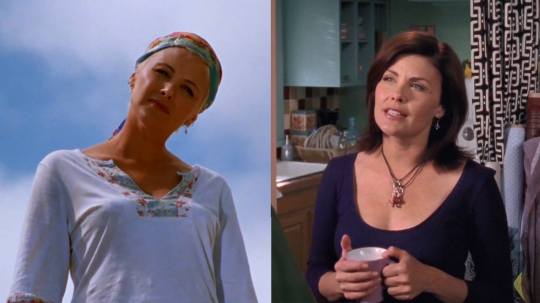
3. And yes cousin Marilyn and Gran, Lorelai the first, Richard’s mother, are the same actress. (Happy Day’s Mrs Cunningham http://www.imdb.com/name/nm0005385/?ref_=nv_sr_1).
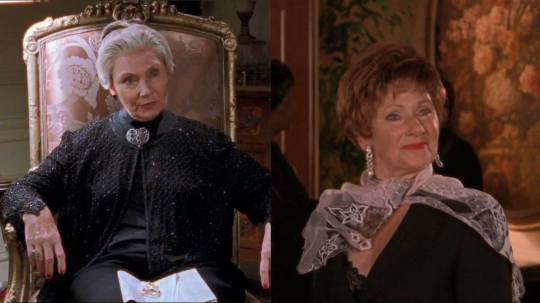
3. Yes the girl in SH high unnamed who asks Lorelai a question and Logan’s LBD friend Juliette are the same actress. Different character. Riki Lindhome played the unnamed student of SH high and Juliette
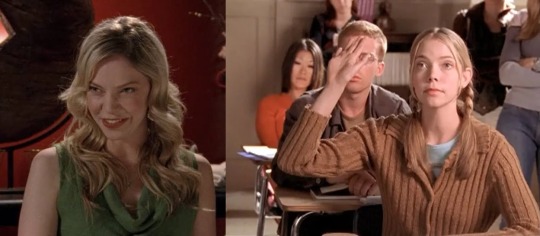
5. Yes the first episode looks completely different (not just in the diner) because it was filmed in a different location (Ontario, Canada).
6. Yes, that’s Luke in Seinfeld. (”sponge worthy guy”) and in Will & Grace, jerk guy obsessed with huge boobs, Grace wanted to impress with the water bra. Lauren was also in Seinfield as one of Jerry’s brief girlfriends. That’s also a young Lauren in Caroline in the city.
7. That’s Chris in friends (hums when he pees guy). Yes that's both Luke and Chris on Will & Grace (Luke water bra artist narcissistic guy, Chris cabin in the woods hot guy).
8. Yes that is Logan (and with Usher for that matter lol) in that scene at 7th heaven . And yes Logan. Matt Czuchry was in the good wife, and he has his own show now “The Resident” on Fox. Currently filming a second season (as in October 1st, 2018)
9. Yes Crazy Carrie was also the Stars Hollow High teacher (by a different name) in the pilot. Same actress that plays crazy Carrie but different name of character
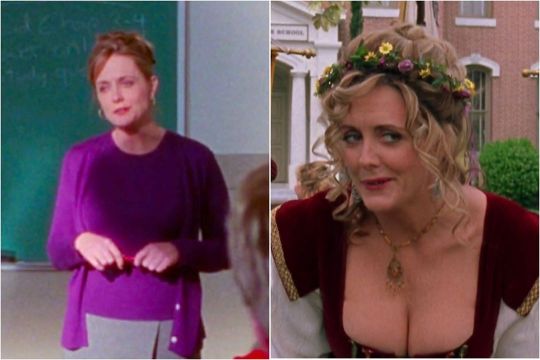
10. No, nobody knows if the show will ever come back (as far as it’s been told everything points to a NO). The Palladinos don’t double book, they are happy doing Mrs Maisel and they devote themselves to one show at the time. The last interview they gave on the subject was to Michael Ausiello in the podcast you can hear in the links. 1. A direct link to the article from November 2017 but is important to listen to the podcast http://tvline.com/2017/11/27/amy-sherman-palladino-podcast-interview-gilmore-girls-mrs-maisel/ 2. This is a link directly to the podcast that opens right up and they say "it would have to be the right time , we don't know but we're open. We said no before and ended up doing more that's why we're open now but it would have to be in a different format", Daniel doesn't repeat the would have to because he already said it right before in the same sentence. Basically is nothing we didn't know. However is a very interesting podcast http://hwcdn.libsyn.com/p/b/8/1/b810a8eea76b5eb5/Amy_and_Dan.mp3?c_id=17932724&expiration=1526427435&hwt=95629606ee9caf86bc57bb8d2d70cf6a. Amy and Dan Palladino show creators and writers and producers, these are the people who made this universe, these are the people who the show belongs to, this is THEIR baby and they made a damn good one.
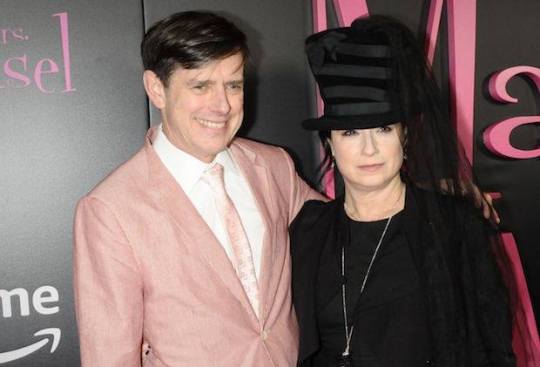
11. No, Lauren Graham did not have cancer and write a book about it. (different person, same name).
12. No, Lauren and Scott didn't hate each other's guts they just weren't BFFs. They have both said this endlessly, they have respect for each other. Scott had a crush on Lauren when he begun the show. But from what has been told and learned about Scott, it seems he doesn’t like to get along with the rest of the cast unless is for his personal gain.
13. NO Rory is not a surrogate. They never even discussed the surrogacy Lorelai with Rory neither did Paris with Rory and Gilmore Girls is a light dramedy not a soap opera it doesn’t have sudden hidden scenes that come to change the show completely, other shows, soap operas could do that, Gilmore Girls DOES NOT. She is NOT pregnant of the Wookie. She never slept with Paul (the actor even said it wasn’t Paul’s) Milo said Jess is not the father and doesn’t romantically love Rory anymore. Only Alexis and Matt were told who the father of the baby is. The Palladinos have said clearly that the father of Rory’s baby was never meant to be a mystery. The only person that fits is Logan. The only actors they have told are Alexis and Matt and told them they could do what they wanted with the information but they have chosen not to say anything because is Amy’s story.And the Palladinos have said IT IS THE OBVIOUS CHOICE. So, Logan is the father, is no cliffhanger is open ending. Yes it would be lovely to see more of them but the Palladinos don’t have the style of wrapping up things in a big pink bow.
14. Ace is Logan’s term of endearment for Rory, it shows respect and admiration, it comes from what they used to call top reporters in the 50’s movies, he first calls her that in a IM conversation at the Yale daily news in the episode season 5 episode 6 of Norman Mailer, I’m pregnant!. Not in the poker game, not in the LDB first gathering. Is a term of respect for her abilities investigating the Life and Death Brigade.
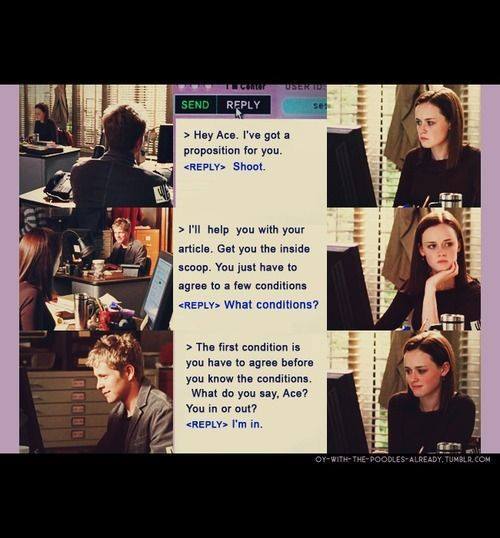
15. The love rocket. Rory understood the meaning because it was the same model, came from an episode of the Twilight zone that was Logan’s favorite. It didn’t need confirmation from Logan because Rory had already said she understood it and she explained it to Lorelai in the same episode: “When Logan and I were first going out, we were in the pool house one night really late, and we were falling asleep on the couch. And this episode of "the twilight zone" came on -- "the long morrow." There's this astronaut who was supposed to go into space for 40 years, but right before he left, he met this beautiful woman. But for those 40 years that he was going to be in space, he was going to be in suspended animation. So when he came back to earth, he was going to be really young, but she would be really old. So he goes into space, and when he does come back, the woman is still young and beautiful because she put herself in suspended animation to wait for him, but he's really, really old because he took himself out of suspended animation so he could be old with her. He spent 40 years alone in space just waiting to see her, and he was willing to come back as an 80-year-old man, giving up almost his entire life just to spend those last few years with her. The point is, that this is Logan's favorite episode of "the twilight zone." And when we watched it together, he said, "that's true love." That's true love! This is the most romantic gift I've ever been given.”.

16. Chris wasn’t at Rory’s high school graduation. He was however at her college graduation. The reason they give is he had to work. Probably the actor who was a guest star was doing another project and couldn’t be in the episode or they just didn’t want to write him in so they could develop more the arc between Lorelai and Luke.
17. June 3rd is the date of Rory’s court date AND the date chosen by Lorelai for hers and Luke’s wedding in the original show. Is the same date different year, coincidence as Lorelai herself says the date happened to happen. There’s a theory that is ASP’s best friend Helen Pai’s birthday. Since it was in an old interview we haven’t found the confirmation of it yet becaue there’s no data (at least on the searches we’ve done so far by various people) on Helen Pai’s date of birth.
18. Lane’s story is loosely based on Helen Pai’s, executive producer of the show and Amy Sherman Palladino’s best friend. HEP ALIEN is an anagram of her name (Pai’s name). Helen Pai’s husband is real life Dave Rygalski which was the character of Dave initially based on until the actor had to leave for a better offer.
19. The real life Dave Rygalski shows up in the troubadour’s “attack” episode, he was with Daniel Palladino who was singing a beaver ate my thumb Dan is singing and Dave is playing the bass. Daniel Palladino is also the town loner, the one who protests at the church and appears briefly in the pilot episode leaving Luke’s. In total Dan Palladino shows up three times in the show

20. Keiko Agena and Emily Kuroda are Japanese American that’s why when they speak korean in very few moments in the show is very difficult to understand for people who do understand korean. Also Mrs Kim’s real name, at least Korean’s name is Jong Ya. Lane’s is Hyun Kyung, without last names, which come first in Korean Culture so Lane would be Kim Hyun Kyung, Mrs Kim however would not be Kim as last name, that’s a westerner tradition, in Korea women don’t change their last name when they marry and they are referred as Madam, Auntie, or as mother of such (name of youngest child) depending on level of familiarity. There’s never a mention of Mrs Kim’s “westerner” first name.
21. There’s also no idea of what Lane’s father does or where he is during the original show. Amy Sherman Palladino show creator said she never saw the need to create or cast a Mr Kim because it was more to focus in the mother and daughter dinamics. No is not the unnamed Asian waiter at Luke’s. Mr Kim appears in the revival for a brief moment, never before. There’s a fan theory going around that he was never there because he had to constantly be traveling to supply antiques for the store. Lane mentions “my parents”, “my mother and father” in a handful of ocassions through the show. He WAS NOT the unnamed Asian waiter that is always at the background at Luke’s. The Palladinos had never made anyone pass for Mr Kim not even as the back of a head until the revival as a way of fan service and as a joke like saying “oh look, so maybe he had been there the entire time”.

22. The translation of the korean wedding ceremony is here: https://missallycat.tumblr.com/post/173812878159/i-got-a-sidekick-out-of-you (is a tumblr post) complete with before and after.
23. What does Lane’s grandmother say when she arrives at the house before the wedding? Grandma takes her coat and she sees Lane, she calls out her name Hyun Kyung-a (the a is an added sound they use for familiarity when they call someone's name) and tells her to come down. After Lane comes down she pats her in the cheek and says Lane is "oh so pretty!". Lane replies, "welcome, grandmother, I am very happy you came." The grandmother then says, "it's good to have come / I'm glad I came." She then talks to Mrs Kim (Yong Ja-ya Jong Ya is the name the ya the added familiarity informal sound), asking why is that Budha statue here in the room?. Mrs Kim says I was going to move it, mother (formal). Grandma walks through the house she's saying, "ugh, it's so dirty and stuffy in here - open a door." Then Mrs Kim says something that sounds sort of like, "rest first, please." When the camera cuts to Lane and Rory giving each other 'the look,' Grammy Kim is saying, "hey, why didn't you come out to the airport?" Mrs Kim maybe replies, "you said yesterday... that I shouldn't..." (and the sentence doesn't finish). Grammy Kim then says, "the atmosphere/karma is bad [in here]. It needs to be changed. Let's bow 108 times."
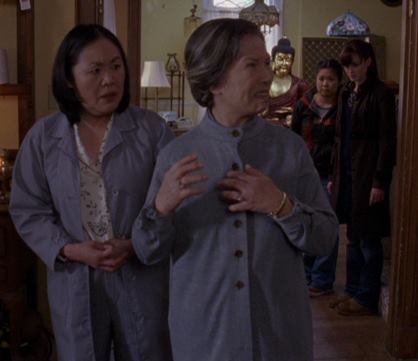
24. The episode of Jess in California “Here comes the son” WAS the backdoor pilot episode of what was going to be made into a spin off. But it wasn’t deemed interesting enough by the network to justify the expenses of shooting in the actual locations so it didn’t happen.
25. Miss Celine and Drella the harpist are the same actress. Alex Borstein. She was going to be Sookie, she was in the unaired pilot but due to conflicts with her other show she couldn’t be so she came later as other characters. She was also the voice in Dwight’s answering machine (especially my trivial pursuit!) and the woman’s voice in the museum. Jackson was married to her but they are divorced know.

26. Paris (Liza Weill) initially auditioned for the role of Rory, she didn’t get it but they liked her so much they created Paris for her.
27. Luke was initially going to be a woman but they figured the show needed more testosterone so they casted Scott. This has been the first and only major role Scott Patterson has had in his entire “career” as an actor, the one that led him to get a few more minor roles, rumor has it, he’s very difficult to work with and not talented enought to be worth the pain. He milks Gilmore Girls every chance he gets.
28. Sookie was going to be gay but the network put a stop to that, they didn’t want any openly gay characters in the show. The Palladinos were new at this so they accepted the network’s conditions. Is probably why Michel was always put as bicurious or closeted gay man during the original show and was only fully out in the revival as an obvious thing that needed no explanation or backstory because everyone always assumed Michel was gay.
29. Kirk (Sean Gunn) was initially just an appearance, Mick in the pilot episode, then swan guy, then Kirk new manager at Doose’s new in town who didn’t know Miss Patty or anyone and then became the Kirk Gleason we know and love. Sean Gunn was initially an extra but they loved him so much they created Kirk Gleason as permanent character for him.
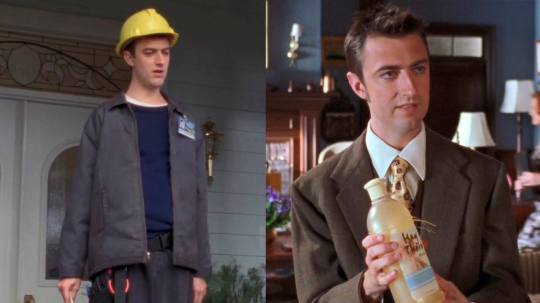
30. Gypsy and Berta, the maid in AYITL are both played by the extremely talented, Rose Abdoo. She was hilarious in a reading when they hadn’t casted anyone yet so she was given the part. Her language is “berta-ese” lol She speaks mostly Spanish, a couple of words could be Brazilian portuguese (maybe?), is mostly nonsensical Spanish words in the kind of Spanish that wouldn’t make a sentence with any meaning or sense and Rose Abdoo said she had changed a few vowels of the words to make it more confusing.G

31. The unkown town elder (towel guy) is played by William Morgan Sheppard. He was never in the show before or after.
32. None of the elders were the same actors or characters of Richard’s two friends in the golf outing with Rory. But one of those friends was the reverend that buries gran, and in the revival is Charlie of the gazette.
33. Rory’s resident advisor Tess the girl who hands her the keys on her first day of Yale (SE04 EP2 “The Lorelais first day at Yale”) is a different actress than Sandee from Sandee says in AYTIL (a year in the life, netflix GG revival) Tess name is Joy Darash http://www.imdb.com/name/nm1384632/?ref_=ttfc_fc_cl_t17 Sandee is Julia Goldani Telles http://www.imdb.com/name/nm5065920/?ref_=tt_cl_t3 (if you ever saw ASP’s show bunheads that’s Sasha)
34. When they take the roadtrip to Harvard. The picture of the girl Lorelai stares at when she’s in the hallway is a stranger it has to do with the year not the girl herself. That's the year she would have graduated if she went to an Ivy league college as it was planned. It was sort of a “what if” moment.
35. Emily Gilmore didn’t go to Yale she went to Smith to study History. Women weren’t admitted in Yale at the time Richard and Emily went to college but it was usual that girls colleges and guys colleges would have parties together and visited each other when there were couples. First mention of Emily attending Smith was in season 5. How many kropogs to cape cod. Richard jokes how Emily got kicked out of the women’s softball team for elbowing another girl. In season 7 I’m a kayak hear me roar, Emily says she went to Smith and majored in History.
36. They talk about Richard’s mother in the first season in past tense but later on Trix appears. It was an error of the first season when things weren’t that defined.
37. Alexis Bledel and Milo Ventimiglia did date in real life, apparently it ended really badly. She also dated Jared Padalecki. She didn’t date Matt Czuchry at least not that is known but both are extremely private people, however they are good friends and trust each other a lot from every interview they have given and enjoy working together. She’s now happily married to her Mad Men costar Vincent Kartheiser and they have a beautiful boy together.
38. Luke’s diner has the sign of William’s hardware store and not Danes’ because as a fandom we assume William was his dad’s first name. You’ll see changes in the diner all through the show. However Luke’s parents names are never mentioned ever during the show. The pilot episode was filmed in Unionville Ontario in a building that was formerly Williams hardware. For continuity when they moved to the studio lot at Warner Brothers the name was kept. I don't remember them ever explaining the name on the series other than the hardware store belonged to Lukes father
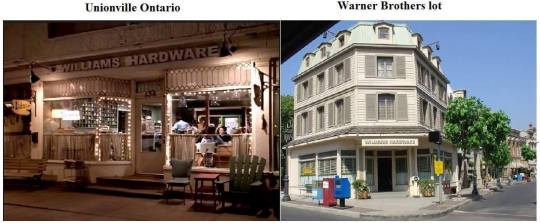
39. Lorelai’s doll house is NOT the same dollhouse on friends but it is the dollhouse they show on sale at Kim’s antiques, in one episode where Lane is going to talk to her mom about the band and Mrs Kim cracks the joke “but is past their bedtime”.
40. Yes Gil from Hep Alien is Sebastian Bach from Skid Row.
41. Yes the “hug-a-world” that was in the garage in season 4 is on their couch in season 1! (Same as the scary clown pillow is in a number of seasons lying around lol)
42. Alexis Bledel is actually a Latina. She was born and raised in the US but grew in a Spanish speaking, latino, household, her father and paternal grandfather are Argentinian, her mother, like herself was born in the US, but Alexis’ mother grew up in Mexico. Alexis didn’t learn English until she started school. The episode where Rory speaks Spanish with Esperanza (Season 6 episode 2: “Fight face”) she anglicized her native Spanish BECAUSE Rory didn’t know much Spanish. There’s an old interview with Ellen Degeneres on set while filming season 6 or 7 that she’s asked to translate for Lauren, she doesn’t translate everything due to nervousness. (It also happens when you live your adult life in a country that doesn’t speak your first language, growing up bilingual, you tend to adopt the accent of the language you use most and tend to confuse some words when you don’t use your native language often).
43. People praised the chemistry and physical closeness between Lauren Graham and Alexis Bledel, but there is actually a very logical reason for this: Alexis was a model and was just starting out acting and had a tougher time making her marks, so as veteran, Lauren often physically moved Alexis to make sure she was in the right place. Lauren told “The Today Show” in 2015: "The camerawork on that show is very specific and we really had to hit certain marks, which especially when you start out, is just a foreign concept...I remember a lot of times just kind of grabbing her, just kind of leading her arm. So, in the beginning, people are like, 'You have such great chemistry.' And I'm like, 'I'm mauling her. That's why.'"
(check this entry from time to time because I’ll keep writing fun facts)
#Gilmore Girls#trivia#gilmore girls trivia#Lorelai Gilmore#rory gilmore#lauren graham#alexis bledel#matt czuchry#Logan Huntzberger
10 notes
·
View notes
Photo

The Times (London, England)
By Roger Lewis
Huge claims are made for Andy Warhol in this massive book. He is, says Blake Gopnik, "the most important and influential artist of the 20th century", who knocked Picasso off his throne. "Andy will go down in history," one of Warhol's teachers asserts, as being "in the same league as Alexander Pope, William Hogarth, Toulouse-Lautrec and Goya as a social critic". To which the only intelligent response is a derisive: pig's bottom!
Warhol, surely, was a tiny overinflated talent, very much a product of Fifties and Sixties pop culture, whose sole insight was that lowly illustration had potential as fine art, that the transitory could be creative. Warhol believed that the "brash materialist objects on which America is built"-- such as Brillo pad boxes, Coca-Cola bottles, Campbell's soup cans, movie star posters and comic books -- had as much right to be displayed in galleries as on trash telly commercials or as props in the colourful films of Jerry Lewis.
But how did anyone think this was new? The Dadaists had been playing games with found objects, and painting moustaches on the Mona Lisa, for years. Toulouse-Lautrec's cabaret posters had long been recognised as genuine art -- and what about Alphonse Mucha, whom Gopnik does not mention? The Czech's fin-desiecle advertisements for soap or lavender water anticipate Warhol's love of packaging, his love of Fifth Avenue shopping sprees.
The Warhols, or Warholas, and before that the Varcholas, originated in modernday Slovakia, on the edge of the Carpathians. His parents emigrated to industrial Pittsburgh, where according to Warhol, "the smog would turn a white shirt black by the end of the day". Warhol was born there in 1928; as a child he was sickly -- he suffered from Sydenham's chorea (then known as St Vitus Dance), which caused twitching and bedwetting, obsessive compulsive behaviour and bad skin.
He wasn't much interested in sports -- "everybody knows that I'm a queen" -- and preferred drawing flowers and butterflies. Warhol enjoyed art class, developing, said a teacher, "a decorative quality that was very becoming". It is true he retained "a childlike directness" -- there was never anything complicated or subtle about his work. Everything is very flat.
Warhol proceeded to the Carnegie Institute of Technology, in his home city, where he did a degree in pictorial design. His earliest jobs were decorating window displays for department stores, and producing campy ink drawings for catalogues and magazines. When he moved to Manhattan in 1949, he instantly received many a lucrative commission from Conde Nast and the Hearst corporation. Warhol decorated deluxe brochures, record sleeves, and even designed a bookplate for Audrey Hepburn.
Gopnik, an American art critic, follows Warhol every step of the way, from cockroach-infested cold-water walk-ups in Greenwich Village to his later Park Avenue mansions, where the rooms, crammed with antiques, were kept locked and unvisited. He was never alone, however.
Warhol's mother came to visit, to do the laundry, and remained for 20 years. She never ceased looking for a "nice girl" for him to marry.
A large part of the Warhol mystique was his personal manner, which overcame his looks. "Andy was one of the plainest boys I've ever seen in my life," said an art dealer from the mid-Fifties, "a pimply faced adolescent with a deformed, bulbous nose that was always inflamed." Yet despite this unprepossessing head topped by a silver wig -- he got his toupee in the early Fifties to cover his thinning hair -- he became an indispensable celebrity, owing more to Quentin Crisp than Henri Matisse. He cultivated a creepy, vampiric manner -- Richard Burton called him "a horror film gentleman" -- and affected to be blank and moronic, speaking in monosyllables.
Underneath the "surface diffidence", however, Gopnik assures us that Warhol was widely read and knowledgeable, well versed in everyone from Cocteau to Fred Astaire. Although he drifted in and out of lots of parties, never raising his eyes, a friend said: "There's nothing he hasn't observed." Gopnik calls him "the world's greatest sponge", sucking up experiences and influences -- and giving nothing back.
What's peculiar is that instead of repulsing people, they were fascinated. When he expanded his studio, and named it the Factory, the place was as thronged as a royal court -- even if Warhol's courtiers were chiefly drifters and no-hopers, "drag queens and queers, street hustlers and rough trade, drug dealers and psychiatric basket-cases".
Warhol found sex (his words) "messy and distasteful". Yet he may not have been as asexual as he sometimes pretended. He underwent surgery for anal warts and took a course of penicillin for venereal disease. Warhol, though, preferred to spend hours on the phone, calling friends to get lurid details of their sex lives. A voyeur, he observed the emotions of others while experiencing none of his own.
This sounds very dead, and deadening. Yet that is the effect of his art too. His famous screen prints, where he would use rubber squeegees to slop paint around photographic stencils, were of electric chairs, car crashes and deceased celebrities, such as Marilyn or JFK -- "chaos pulled from the media". Jackie Onassis is the tragic widow. Elizabeth Taylor joined the club because of her myriad near-fatal illnesses. Everything is depicted in violet pink, orange, poison-apple green and magenta. In the 2,700 images Warhol made of Mao, the Chairman looks embalmed.
In 1968 the Grim Reaper nearly polished off the artist himself. Valerie Solanas, "a troubled hanger-on" at the Factory, shot Warhol at point-blank range, annoyed that he had misplaced the typescript of her play Up Your Ass. Luckily, at the hospital, Warhol ended up in the hands of a highly trained surgeon who knew all about bullets. But Warhol's innards were wrecked (he had a "monumental hernia" and his addiction to Valium caused constipation so bad that he needed daily enemas), contributing to the gall bladder trouble that killed him in 1987, at the age of 58, the organ having become gangrenous.
The effect of the shooting was to drive up the value of Warhol's work, and by now there was a team of assistants churning out print runs of 2,500 -- multiple repeat images of Elvis or Shirley Temple, cans and bottle tops. It was as if Warhol was insisting on the virtue of monotony and banality, with pictures that were, his dealer said, "blank, blunt, bleak, stark".
When we are informed, by Gopnik, that "Warhol always talked about his love of boredom", it is fair to say there's no surprise there: the soporific effect of his prints of stamps or banknotes; his films about someone sleeping or the Empire State Building doing nothing; his fondness for tape recording inane chatter and for taking blurry Polaroids at Studio 54 -- with Warhol, form and content were as one.
Towards the end, he dumped his riff-raff followers and sought the company of minor European royalty and the Shah of Iran, desperate to secure portrait commissions. He collected Czech folk art, decorated eggs, carpets, vintage store signs, carved carousel horses, Slavonic church icons. He packed ticket stubs, receipts and Christmas cards into 609 boxes, which he called Time Capsules, the more ephemeral the better. He surrounded himself with the bric-a-brac of his own mausoleum.
Screen prints, priced at $800 originally, now fetch $105 million at auction. The estate, its headquarters in Pittsburgh, is worth billions. Although I always liked the exquisite drawings of perfume bottles or shoes, the laces and filigree and bits of gold leaf, Warhol destroyed his archives of early commercial art. He wanted to be remembered only for his society portraits, which are tawdry. Much like this appallingly bloated book, with its naff prose: "licking his lips at the prospect", "muddied the waters", "dipped a tentative toe", "to add injury to insult", "spent a pretty penny".
Asked why she shot Warhol, Solanas said: "He's a piece of garbage." His work mostly was. Up Your Ass was finally staged in 2000.
A Life as Art by Blake Gopnik Allen Lane, 930pp; PS35
2 notes
·
View notes